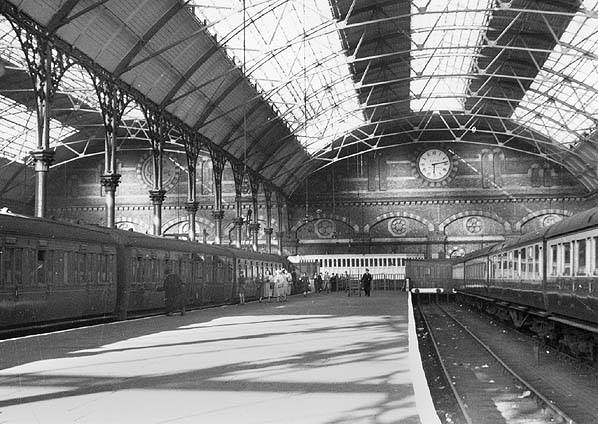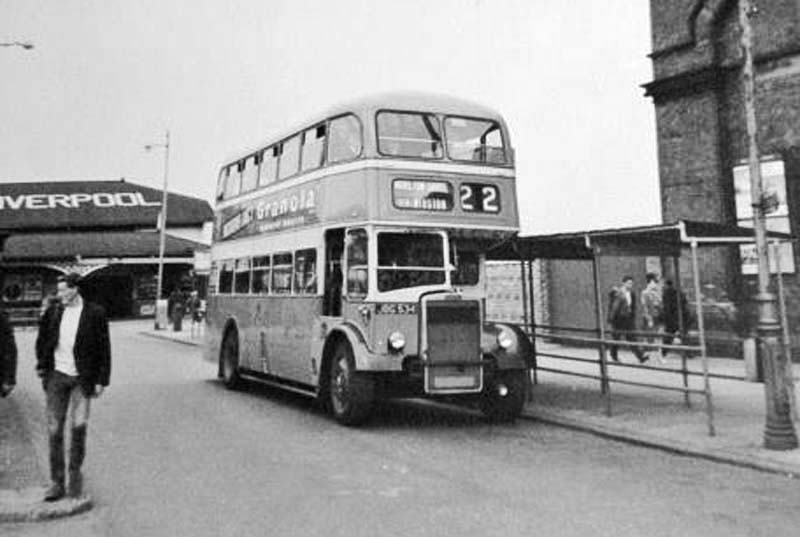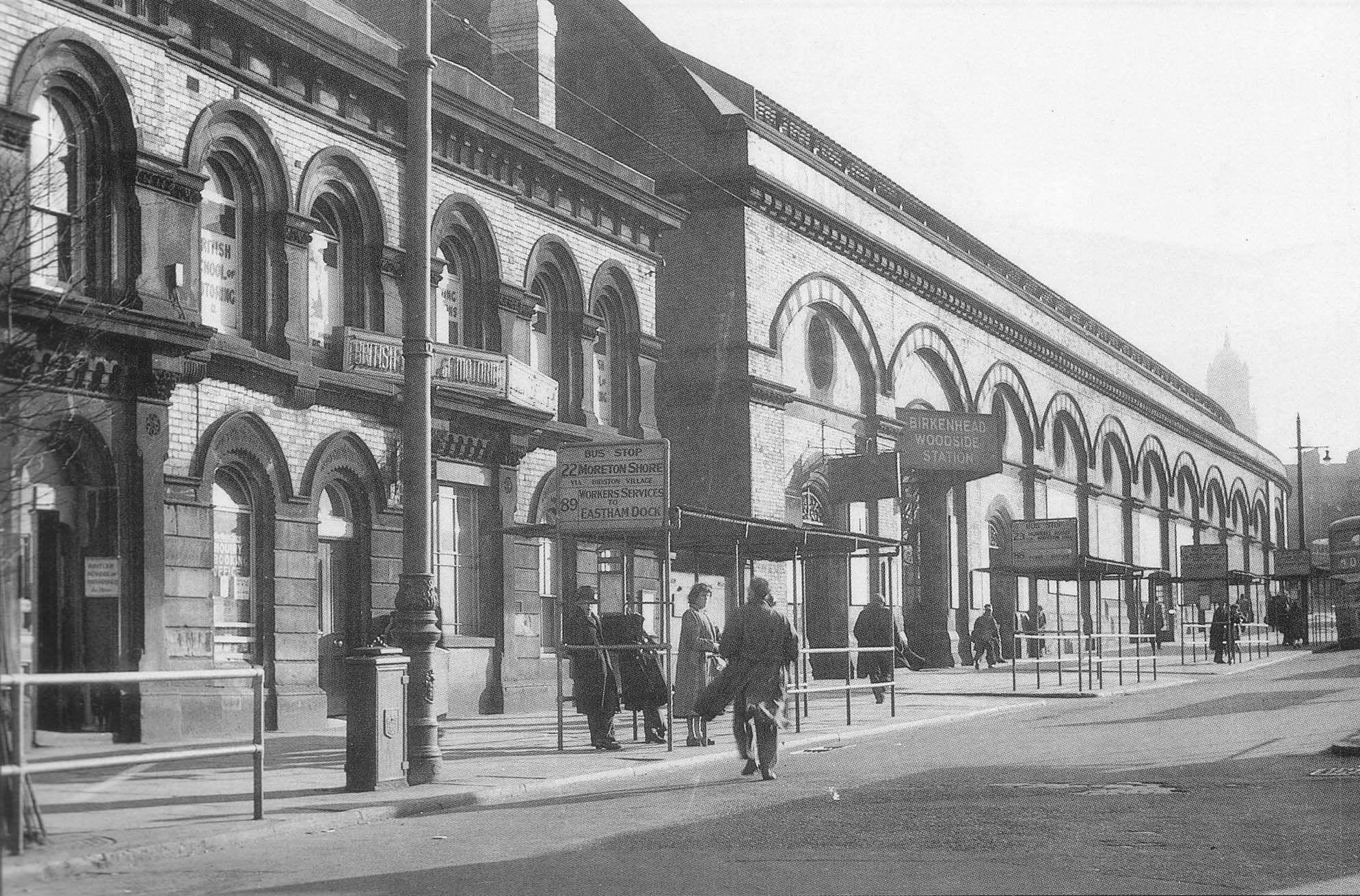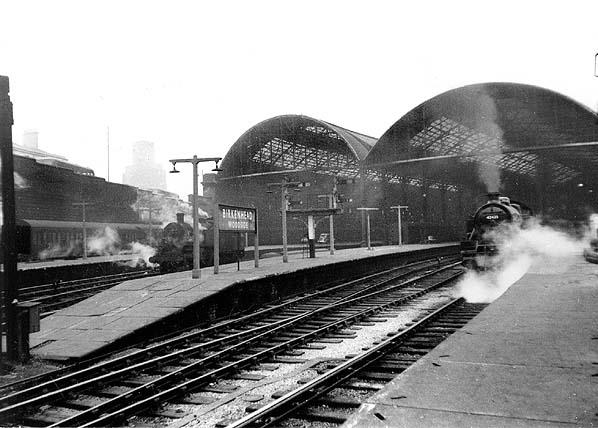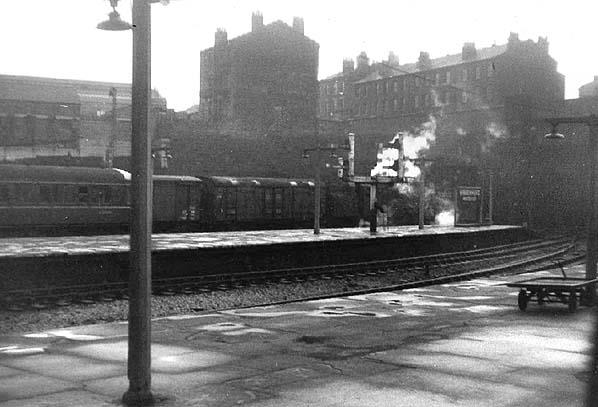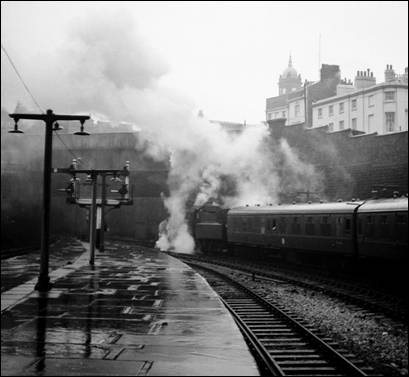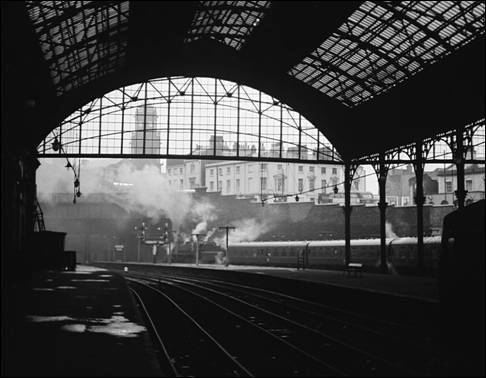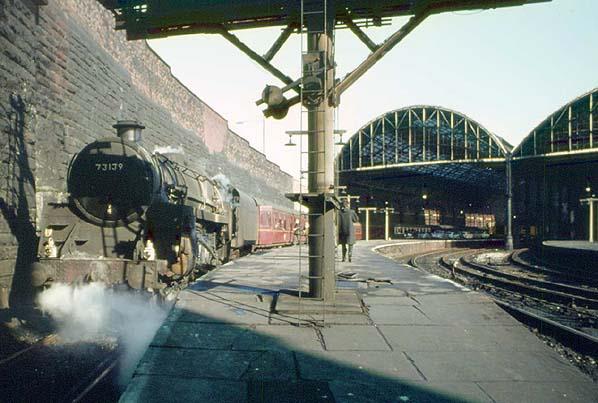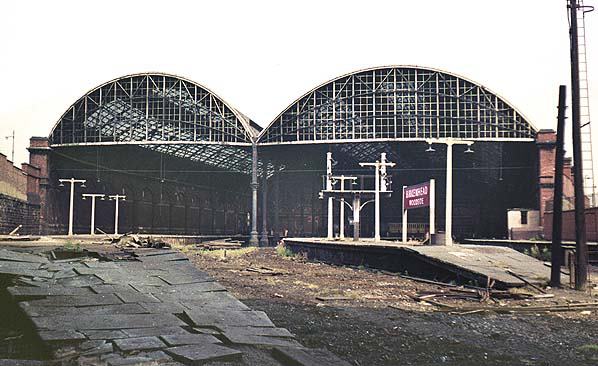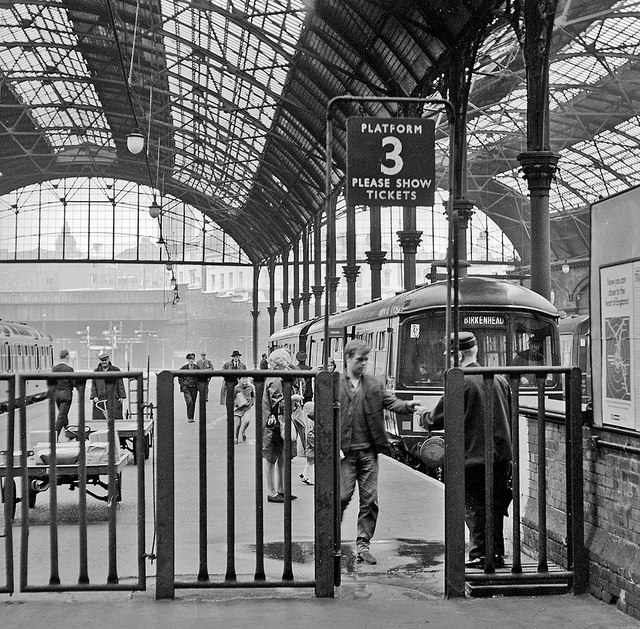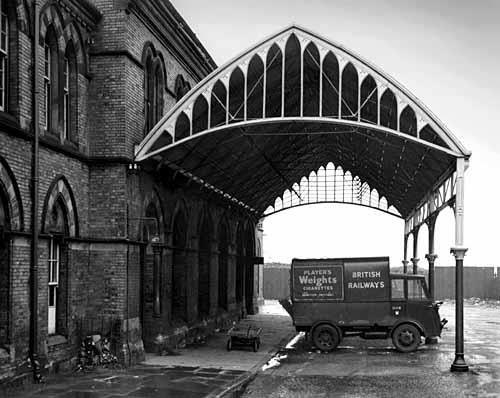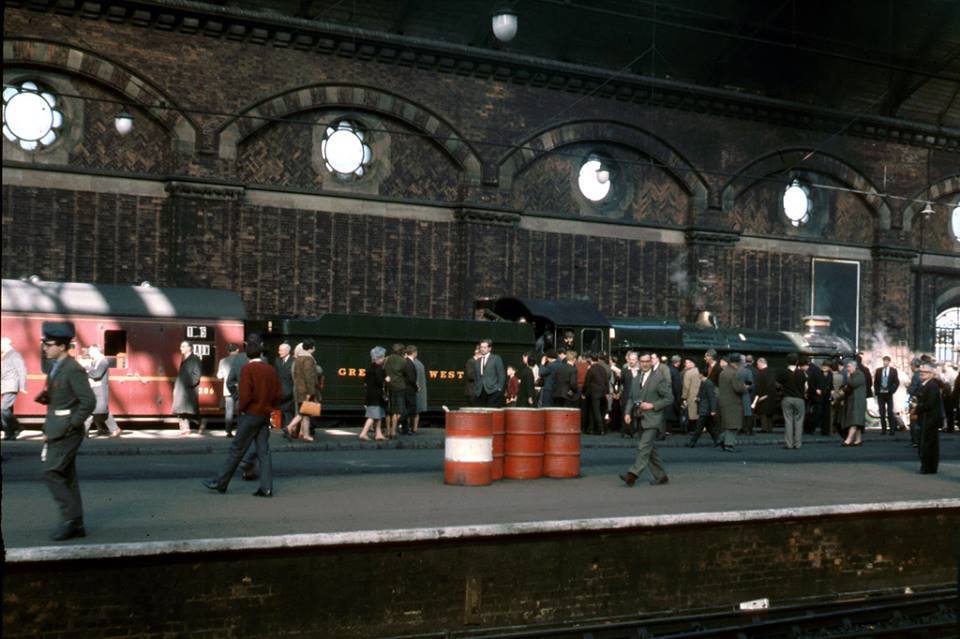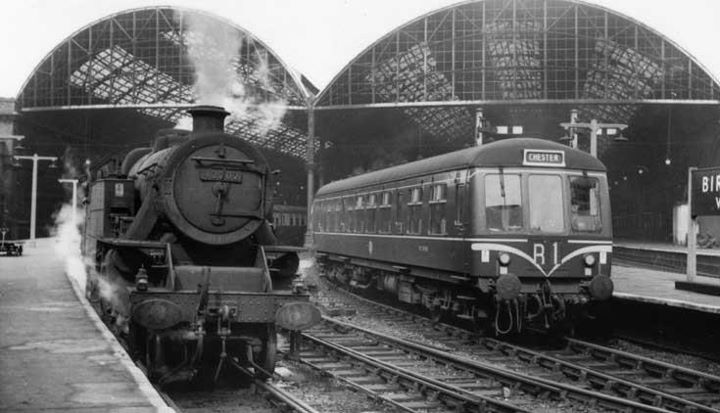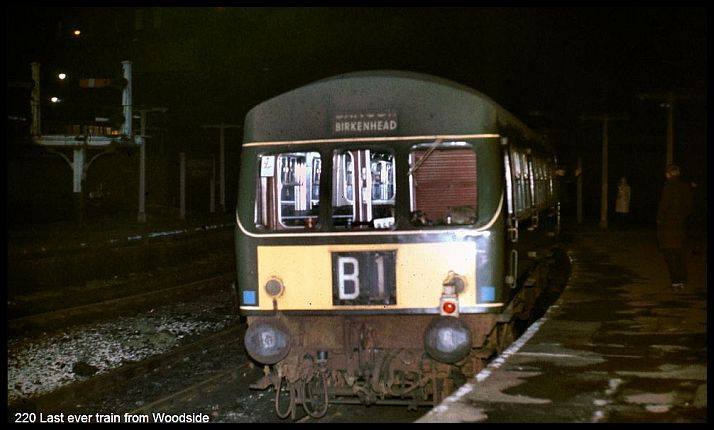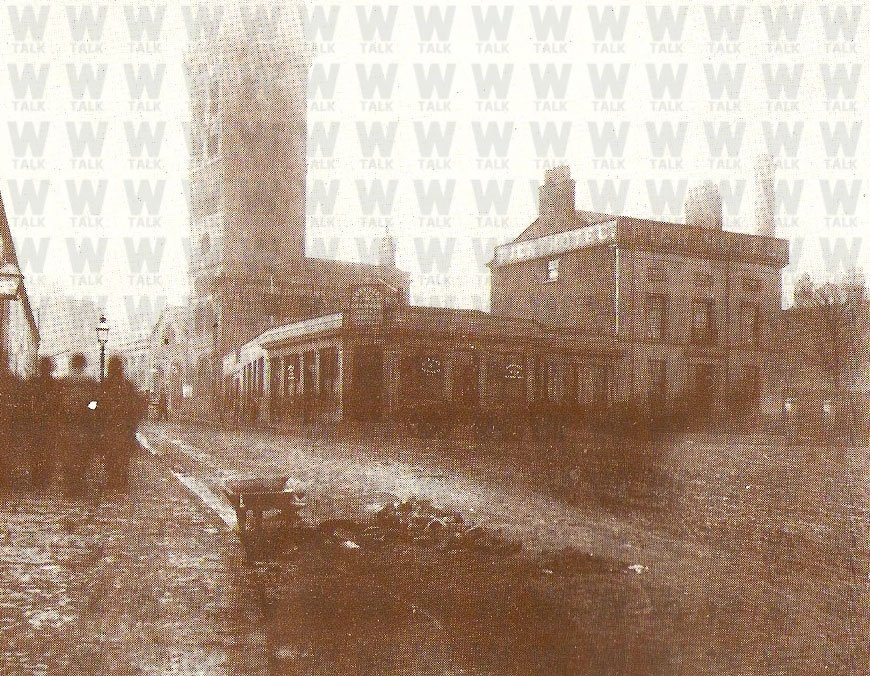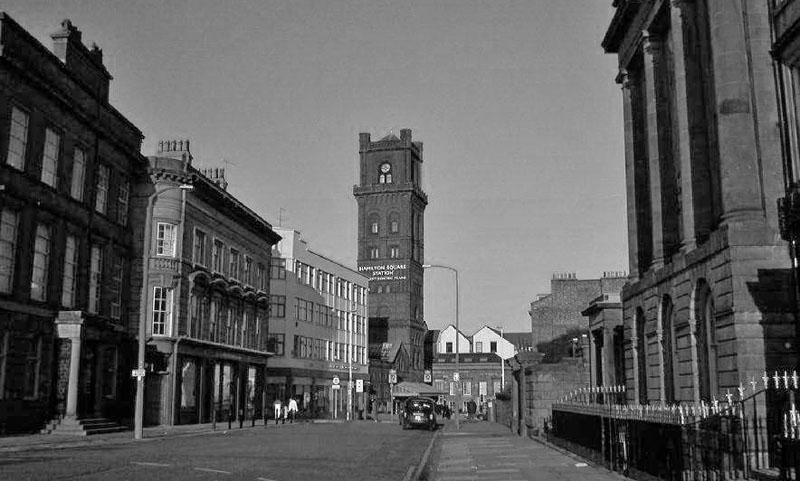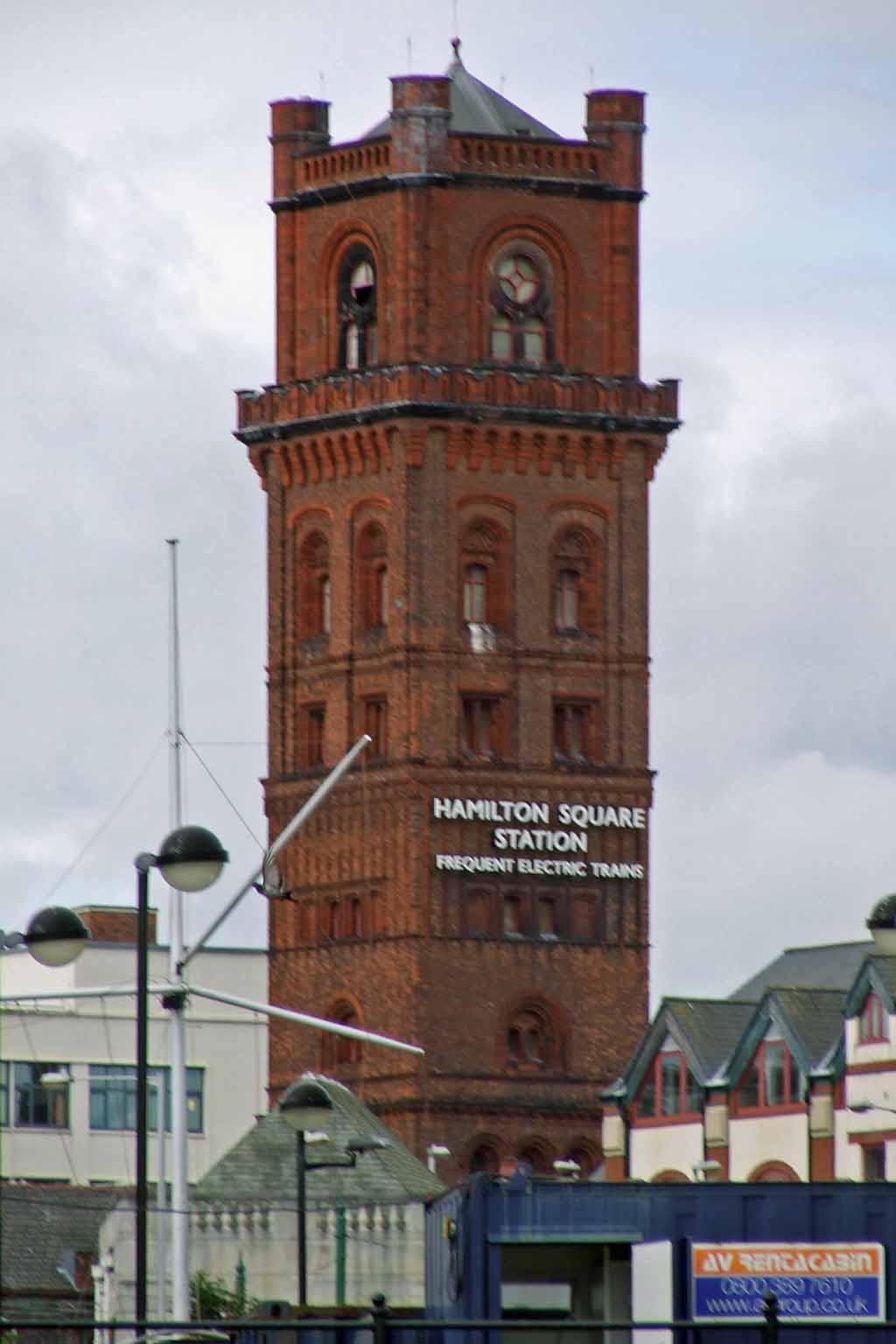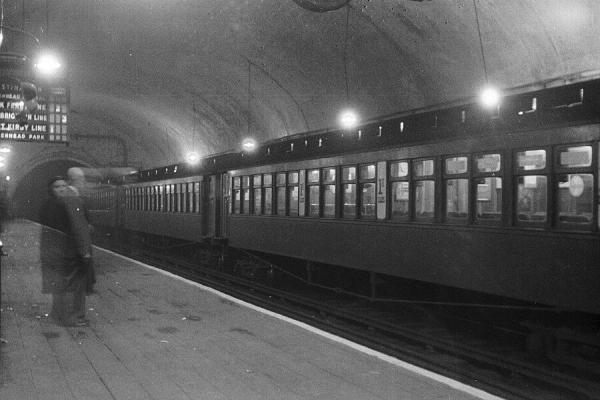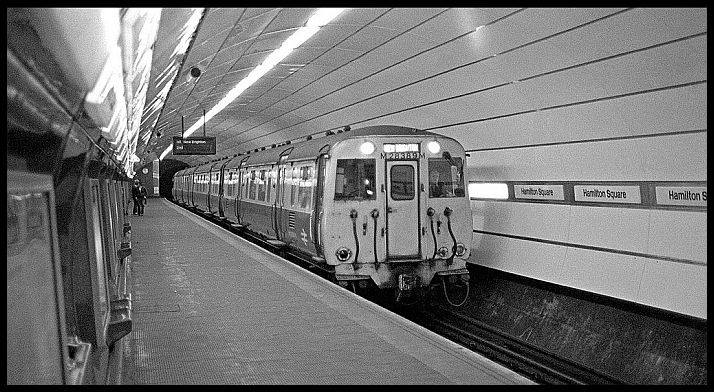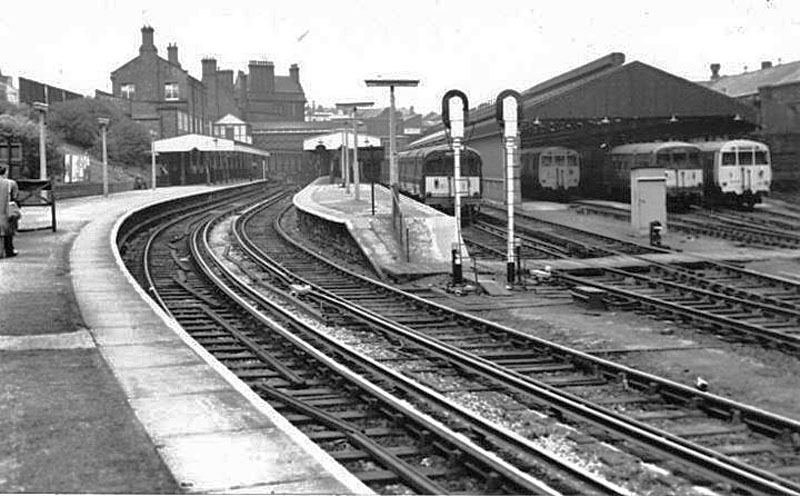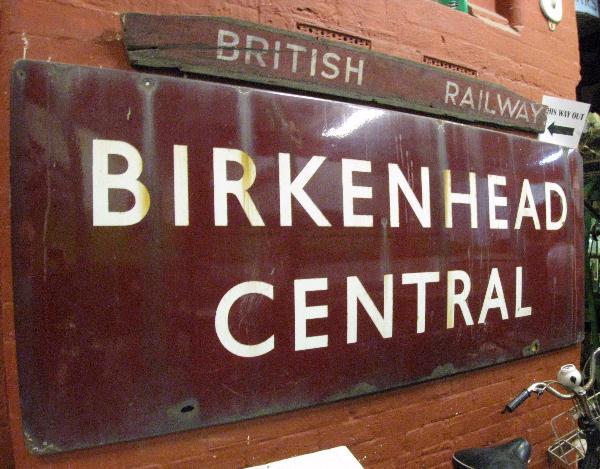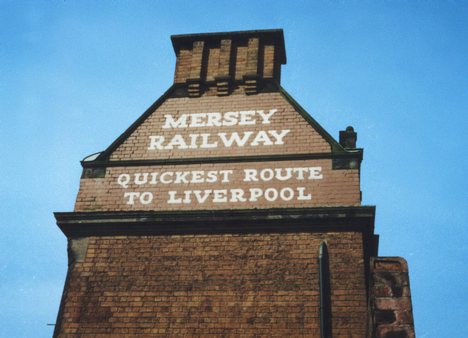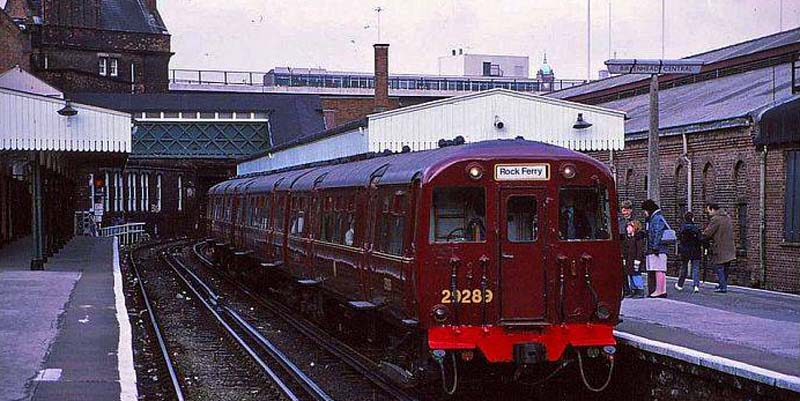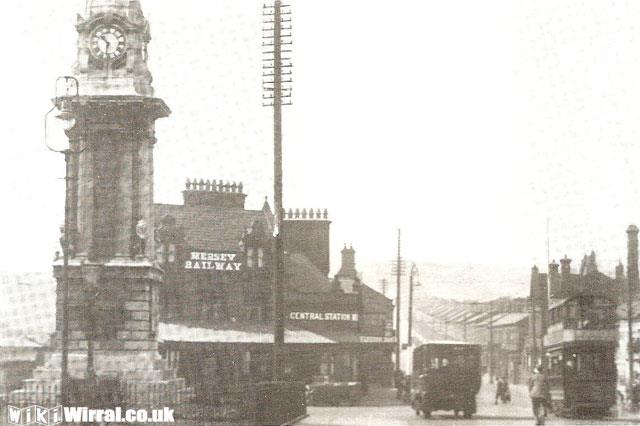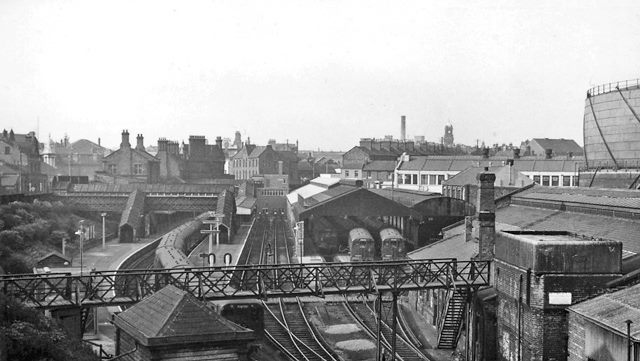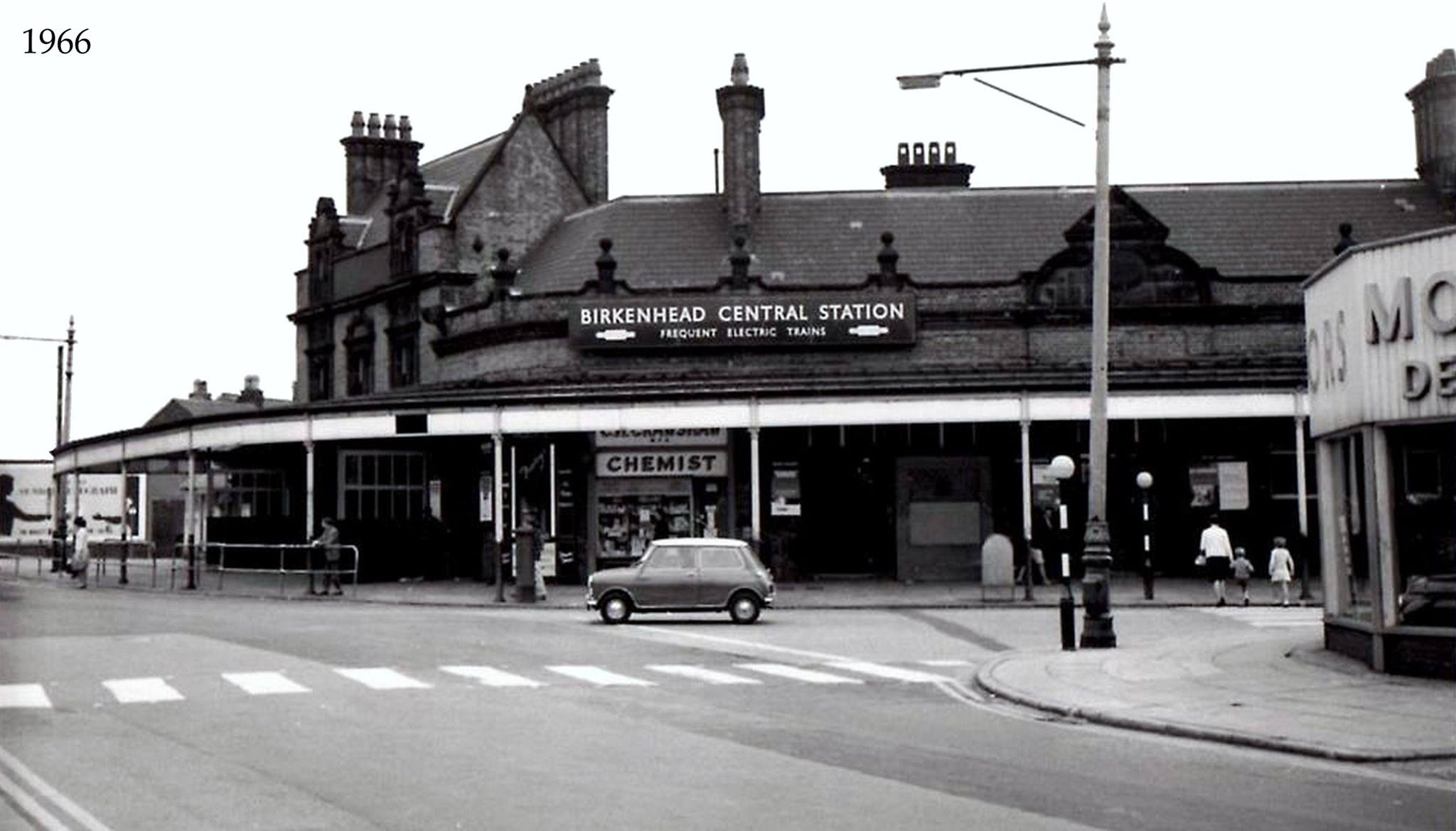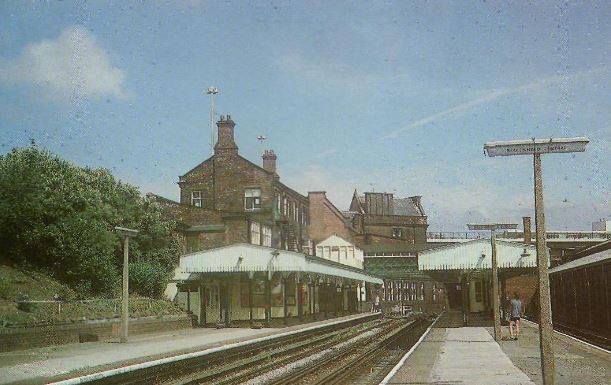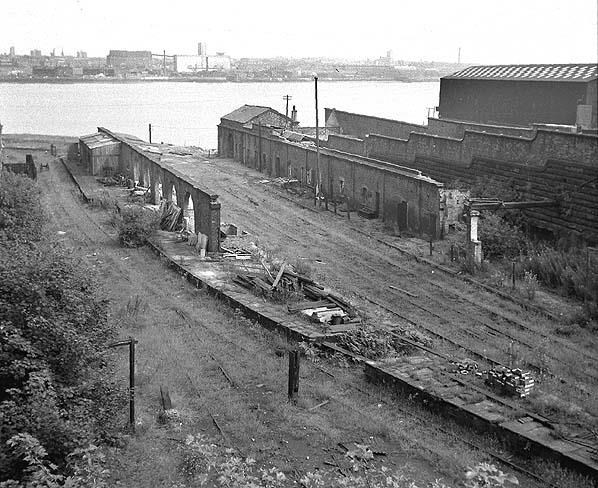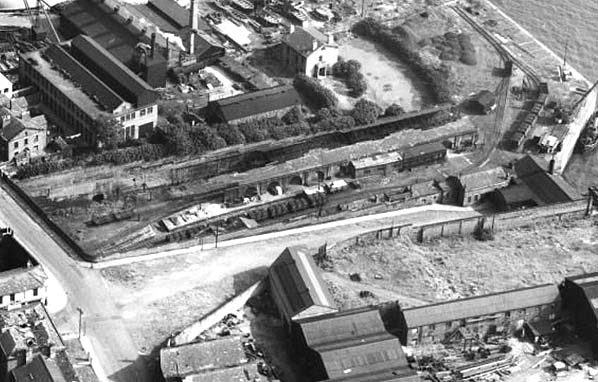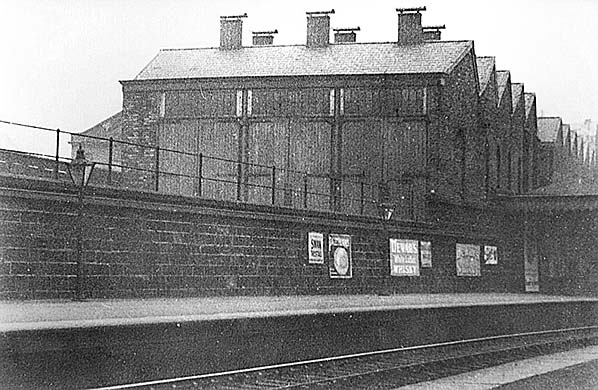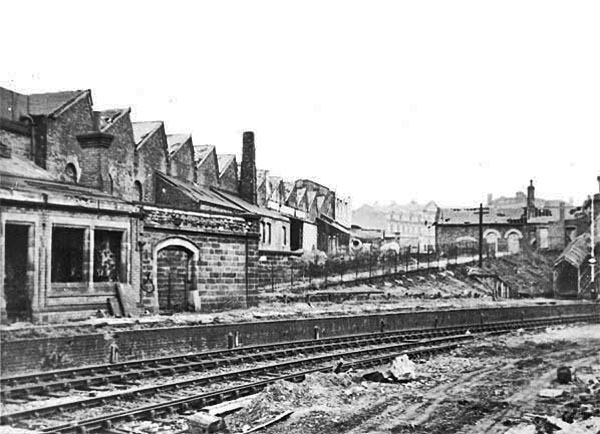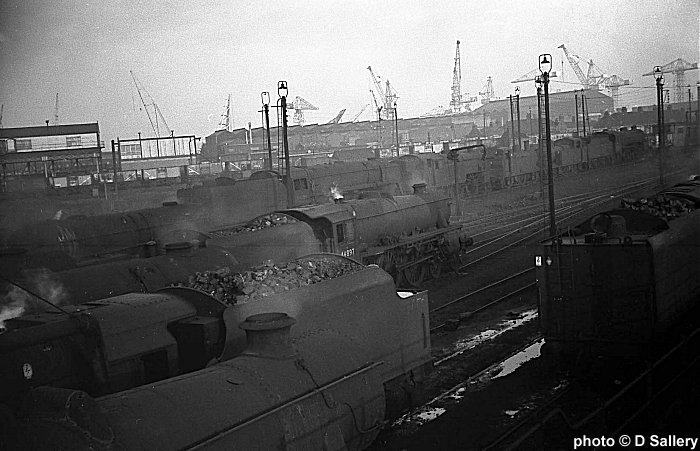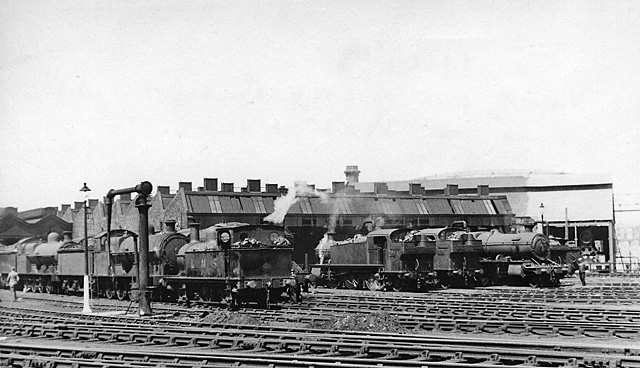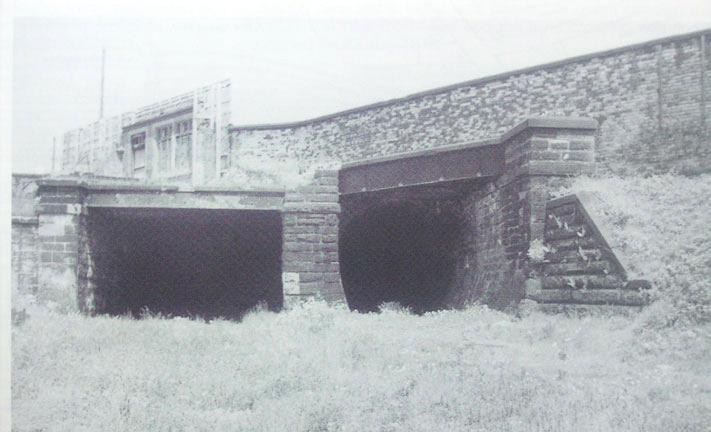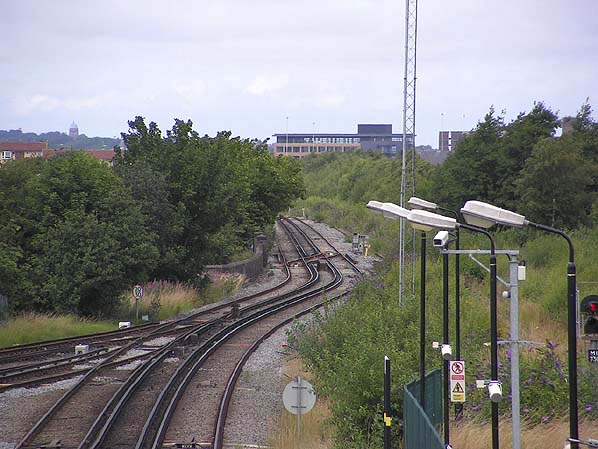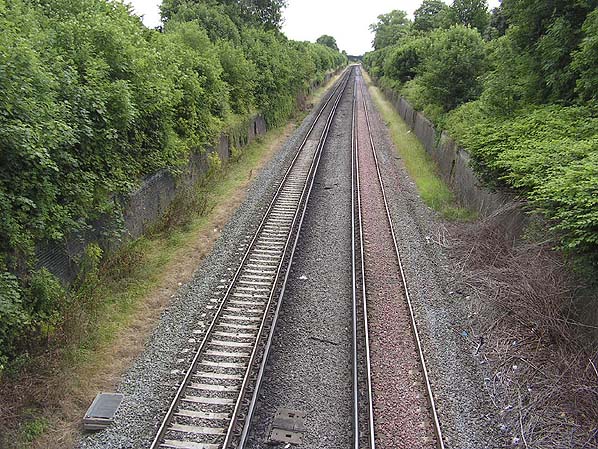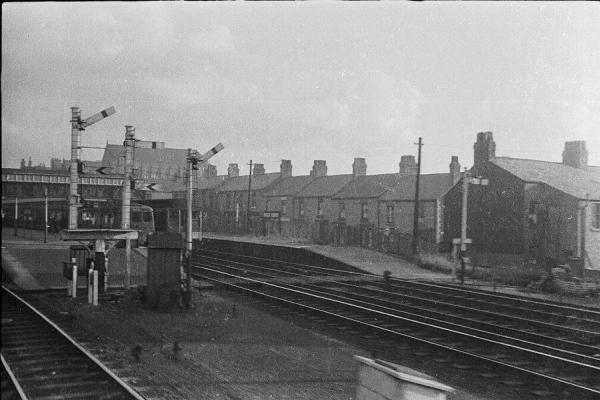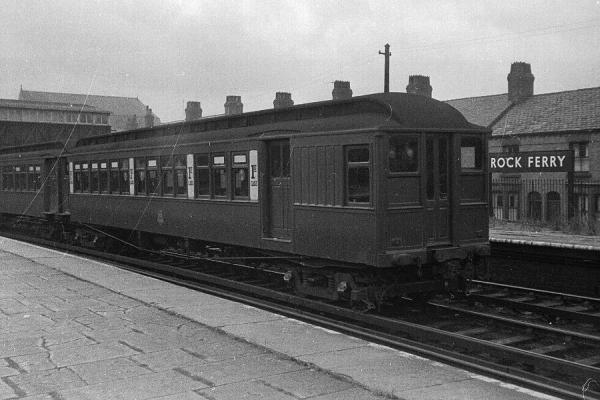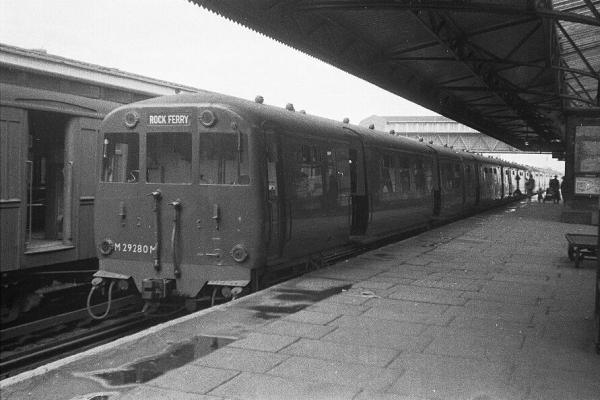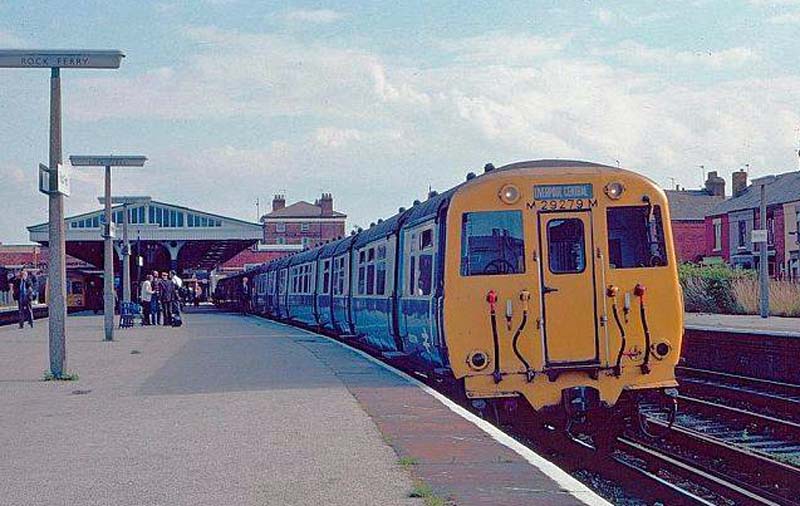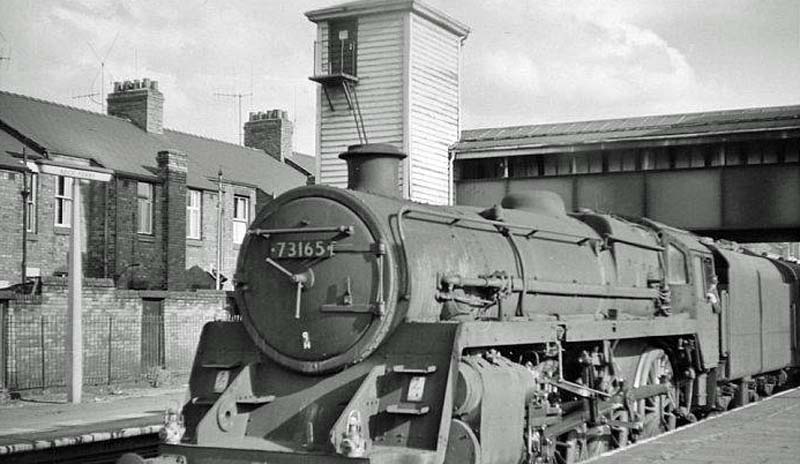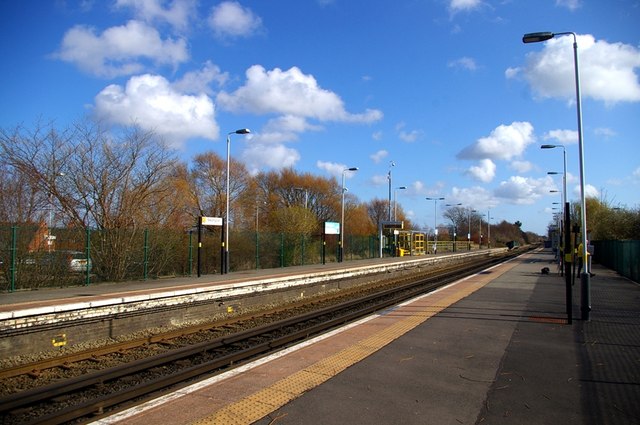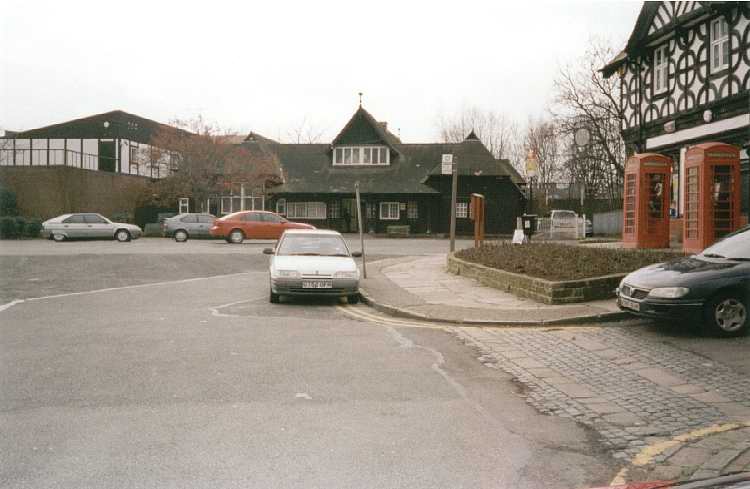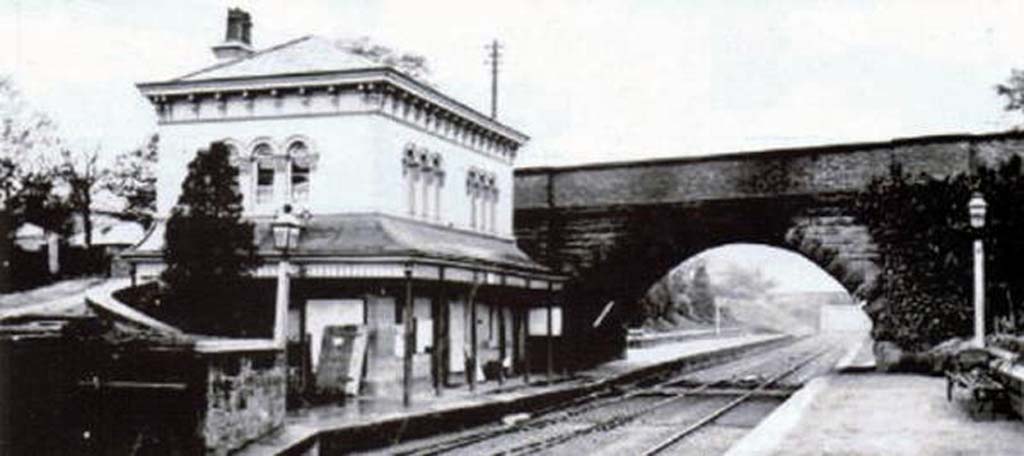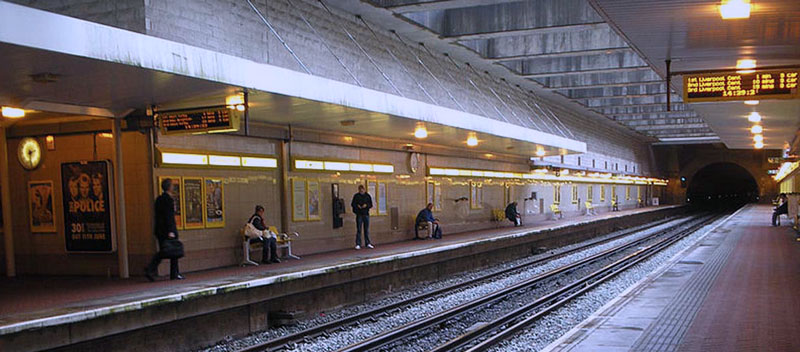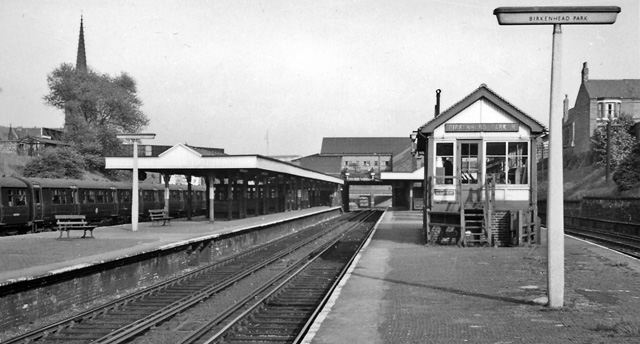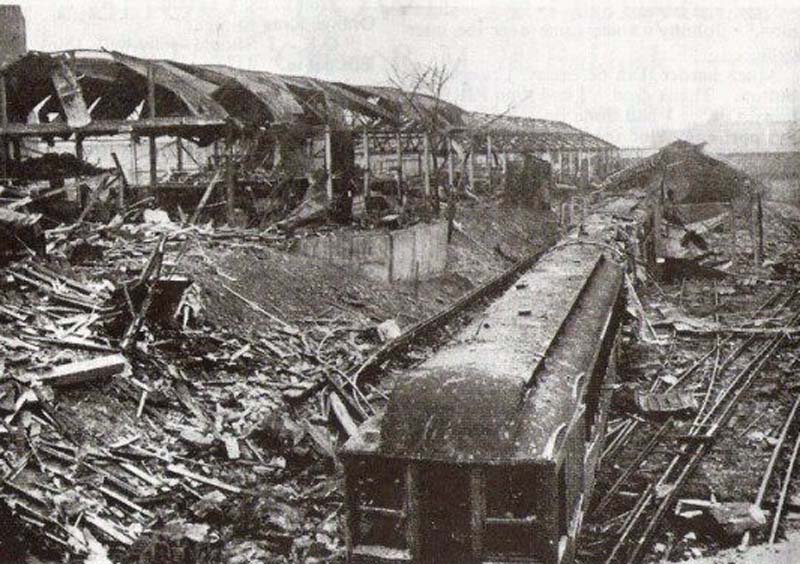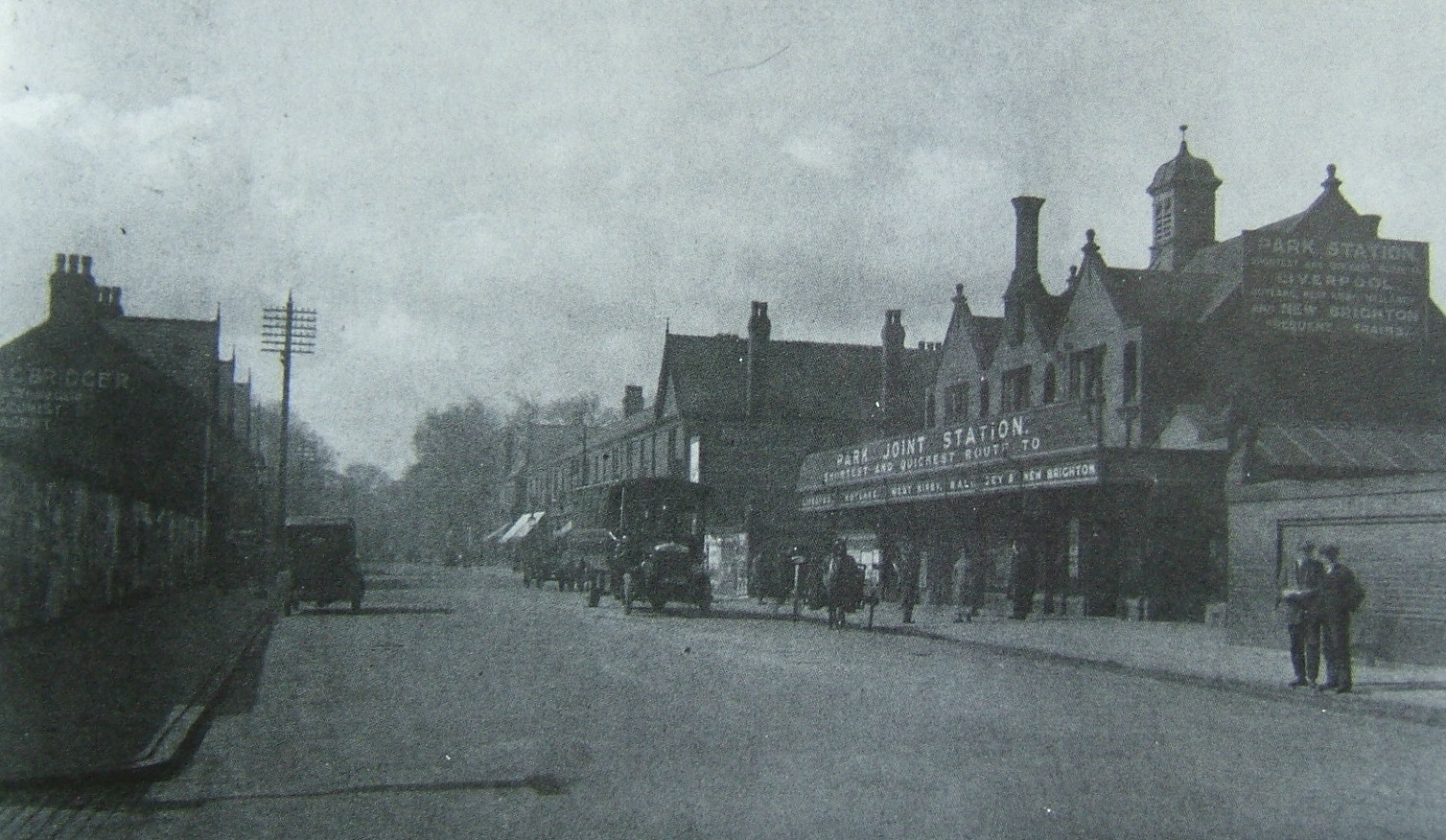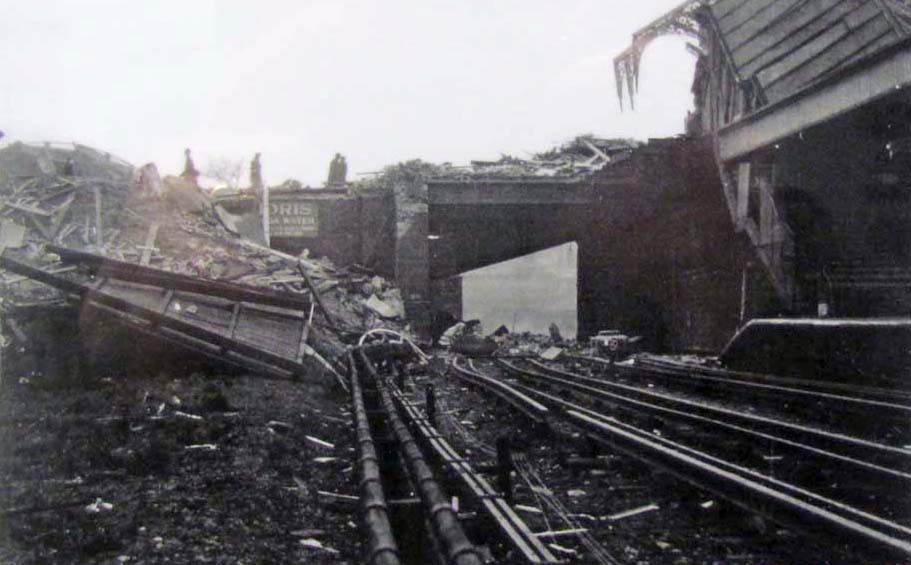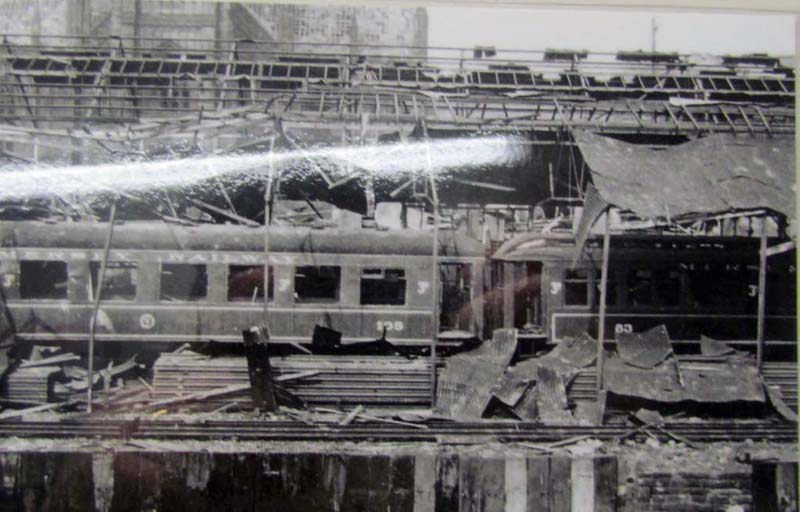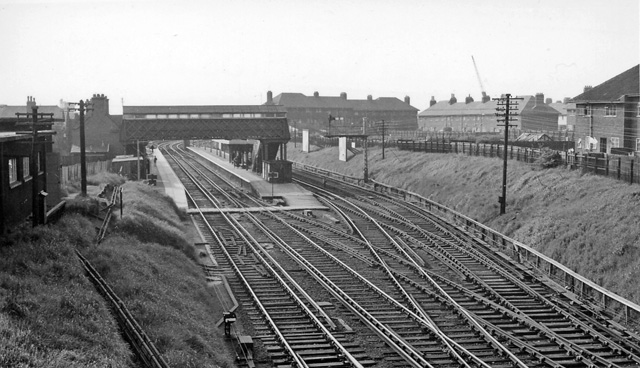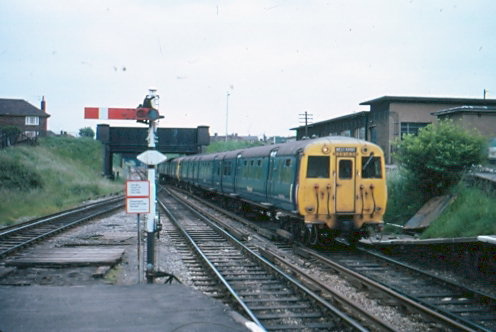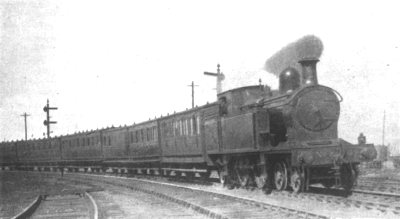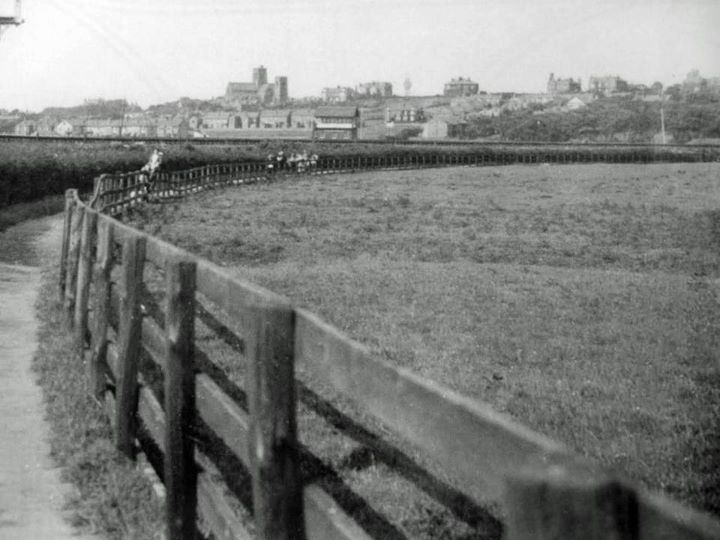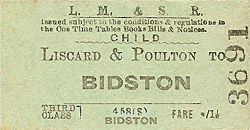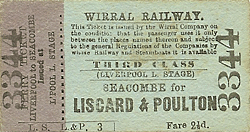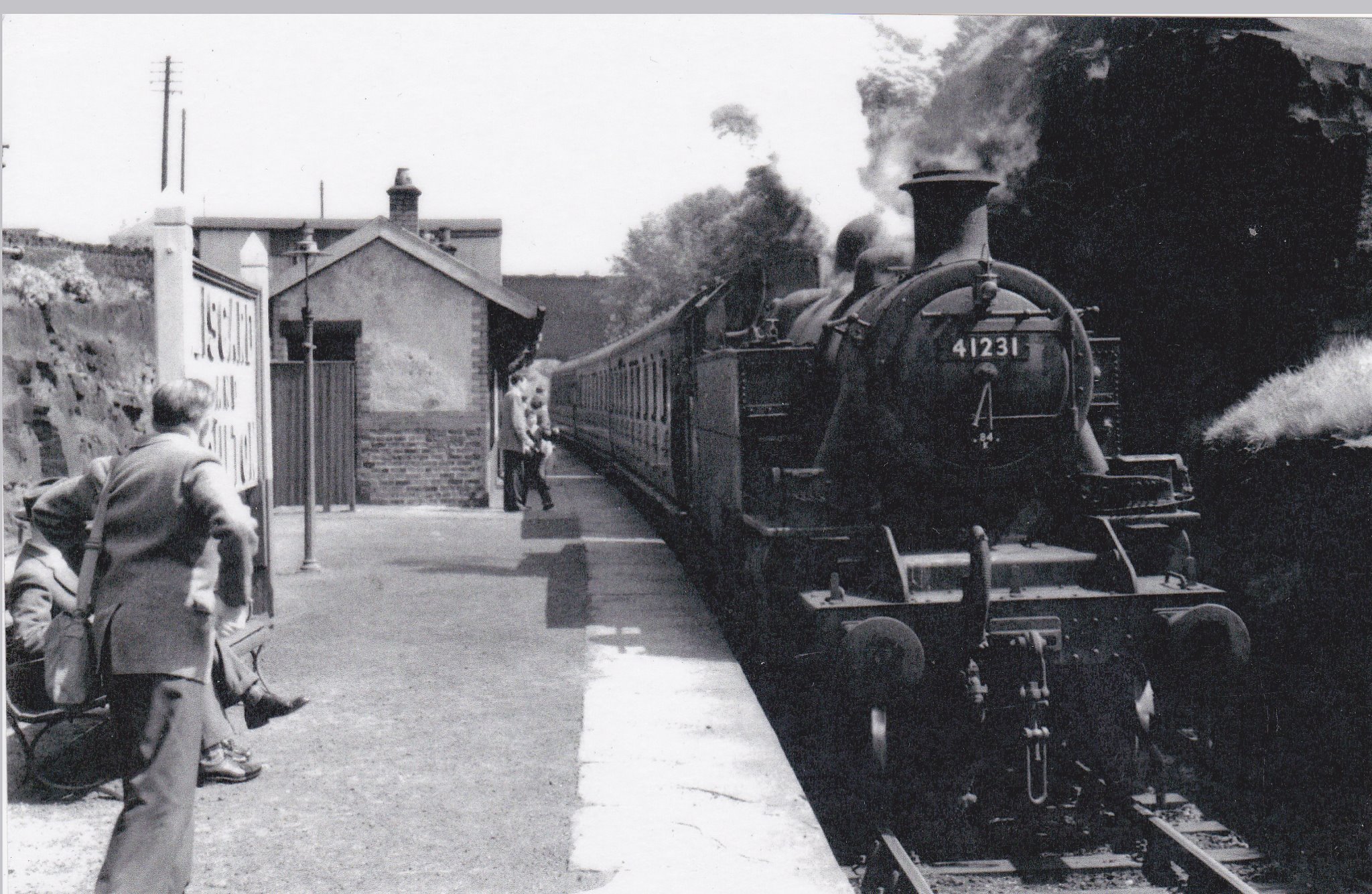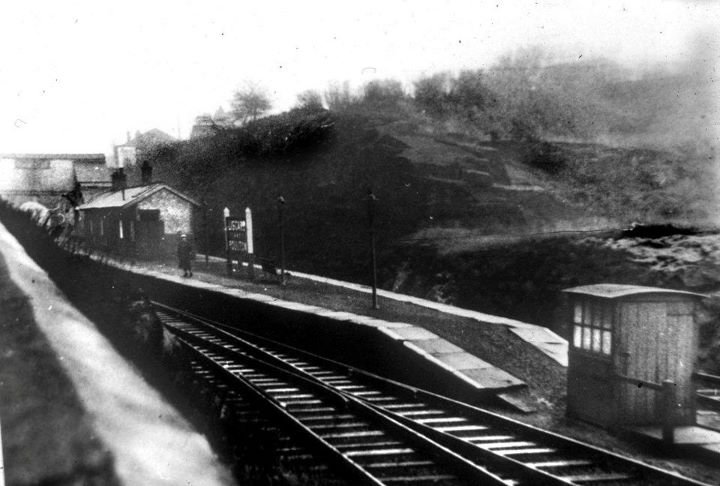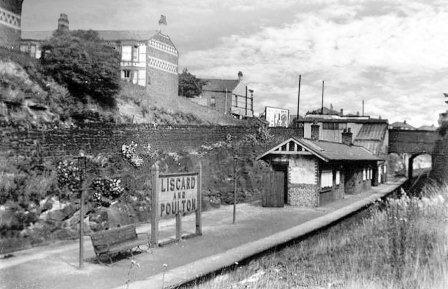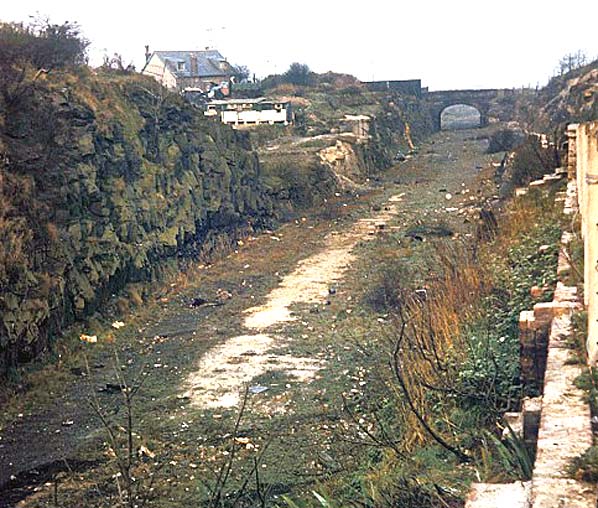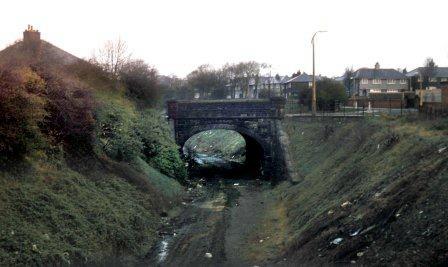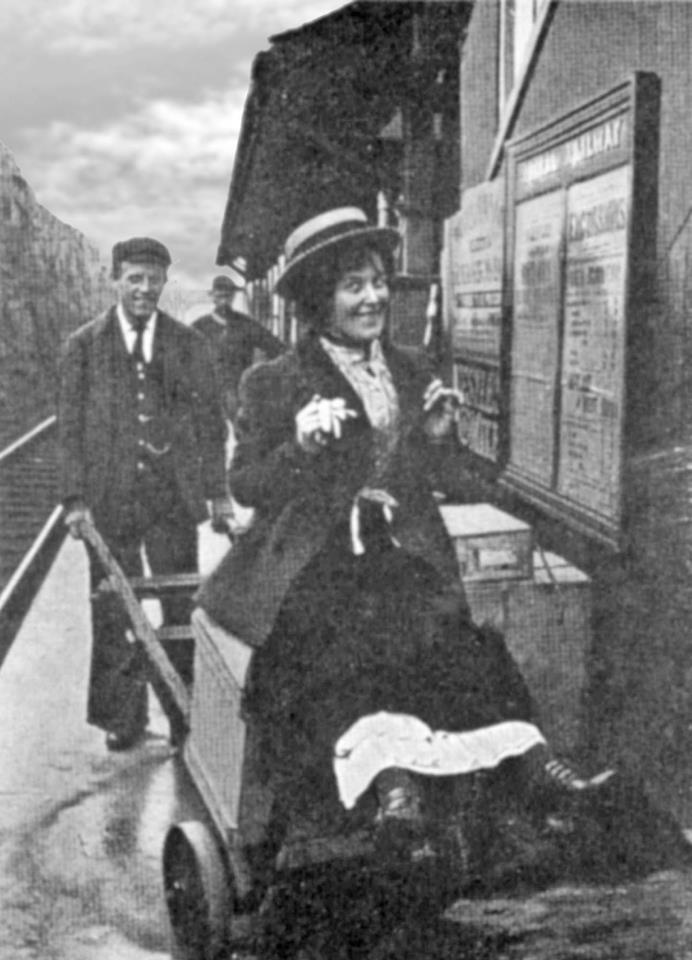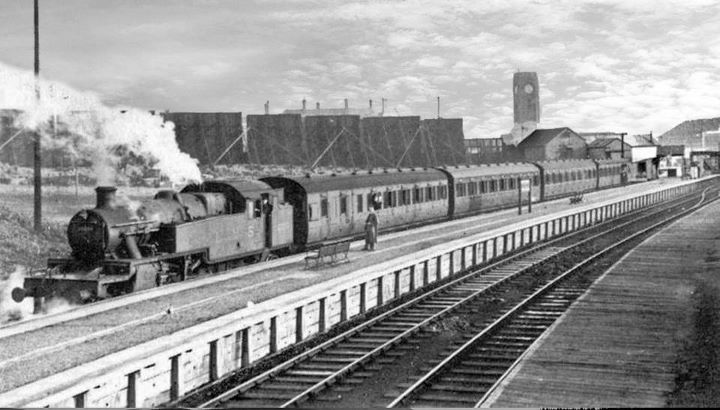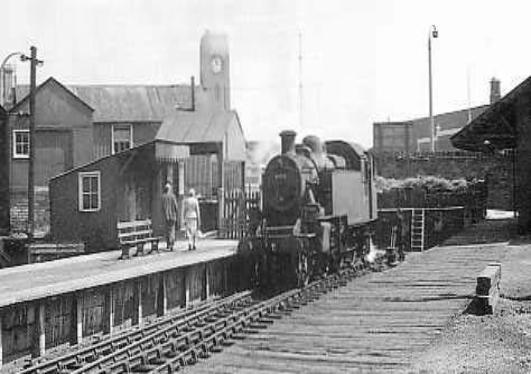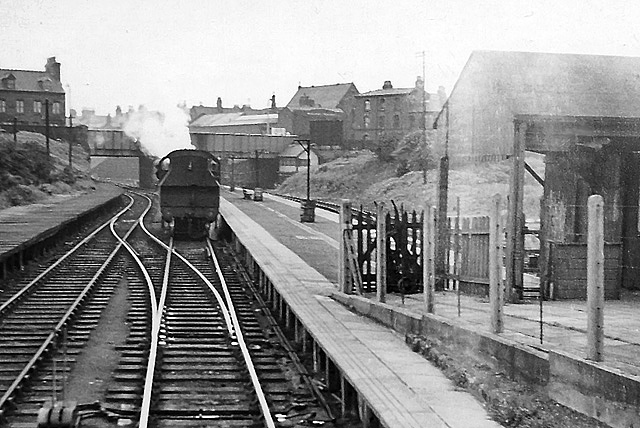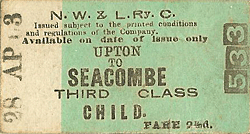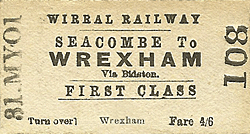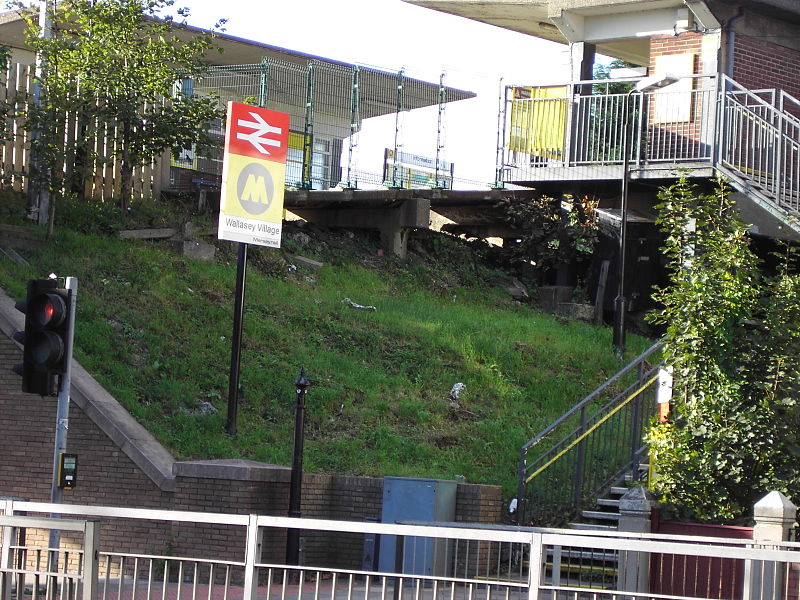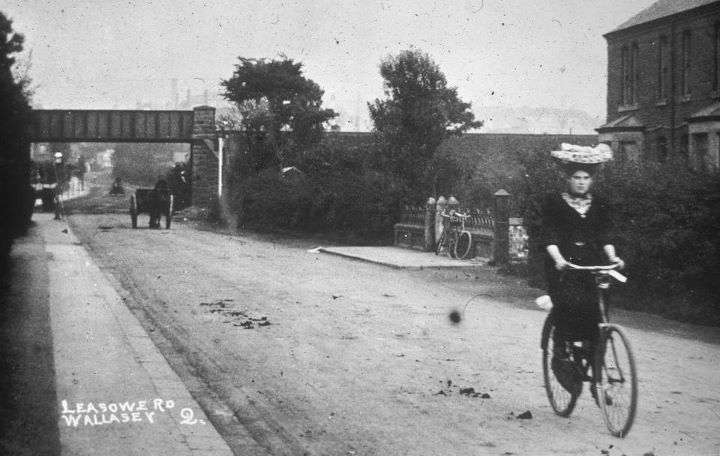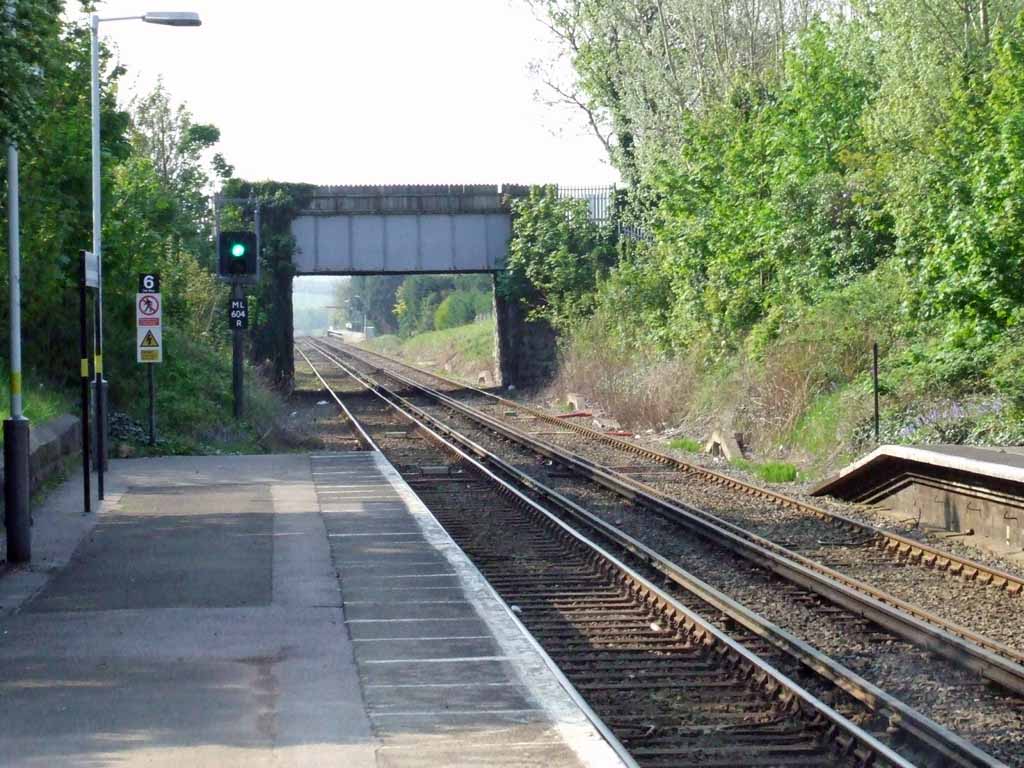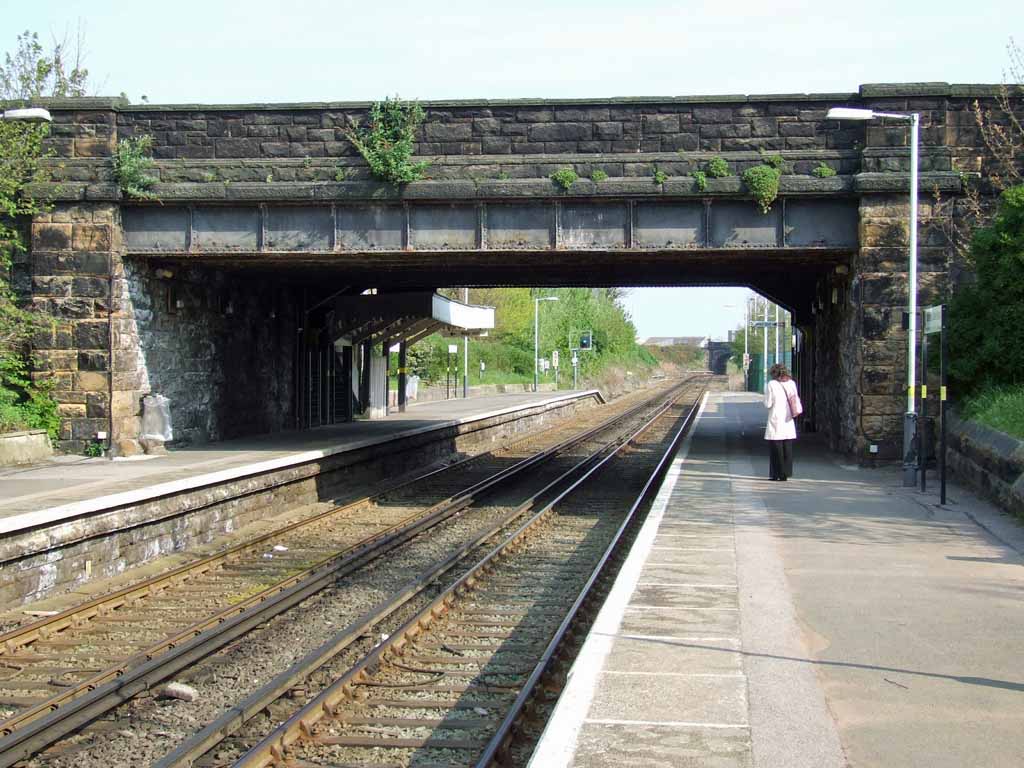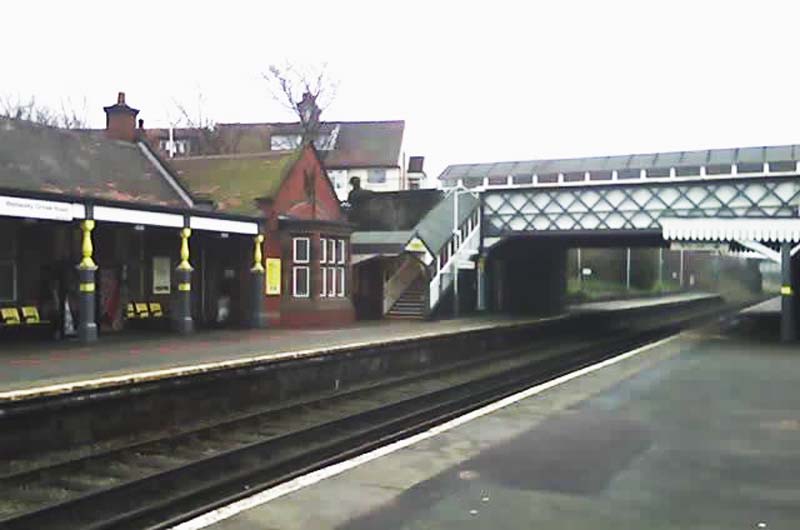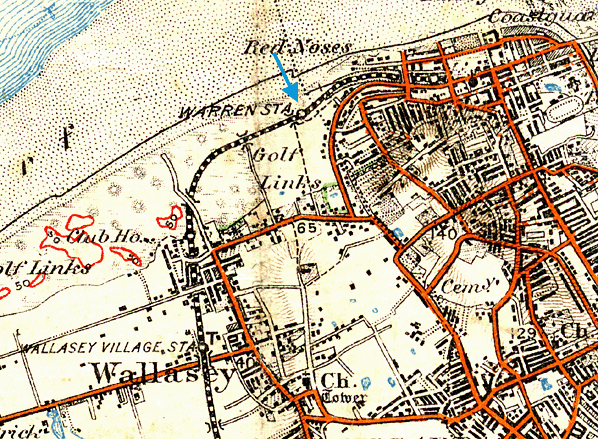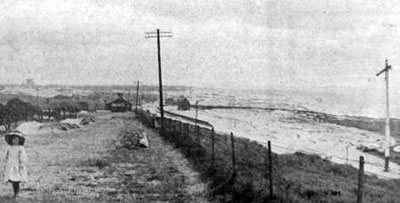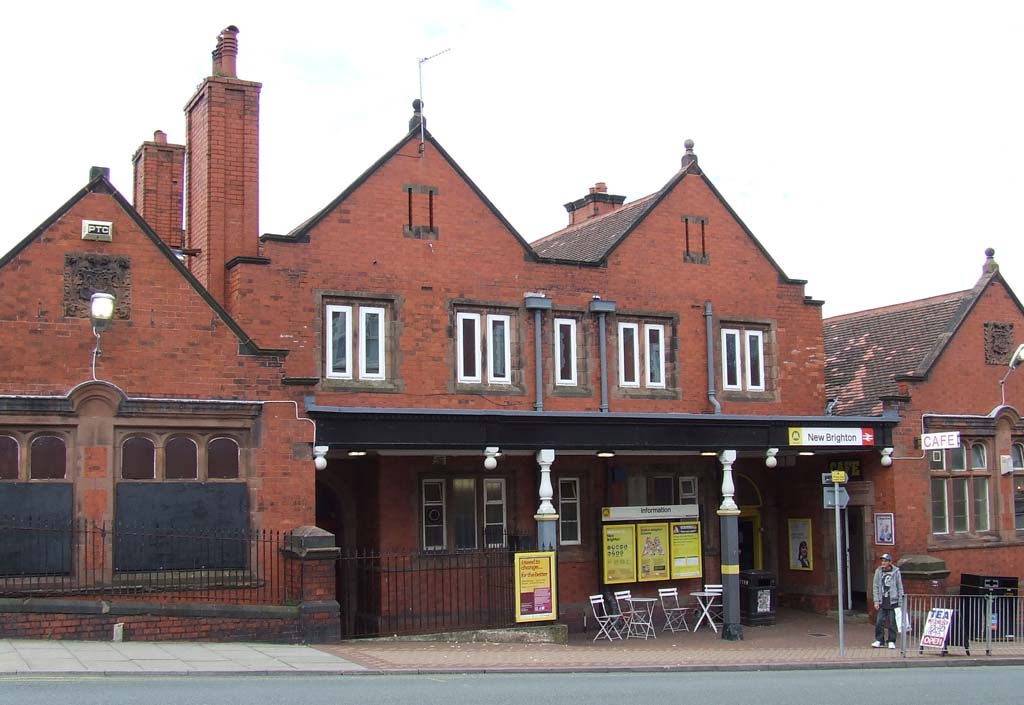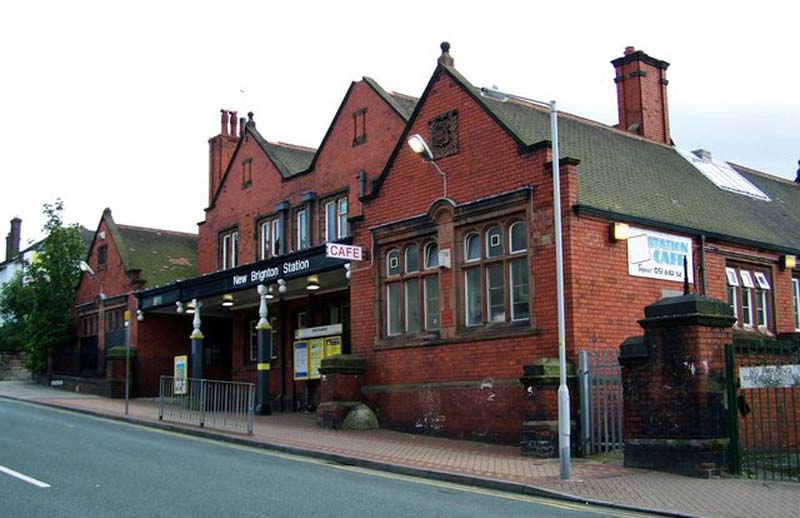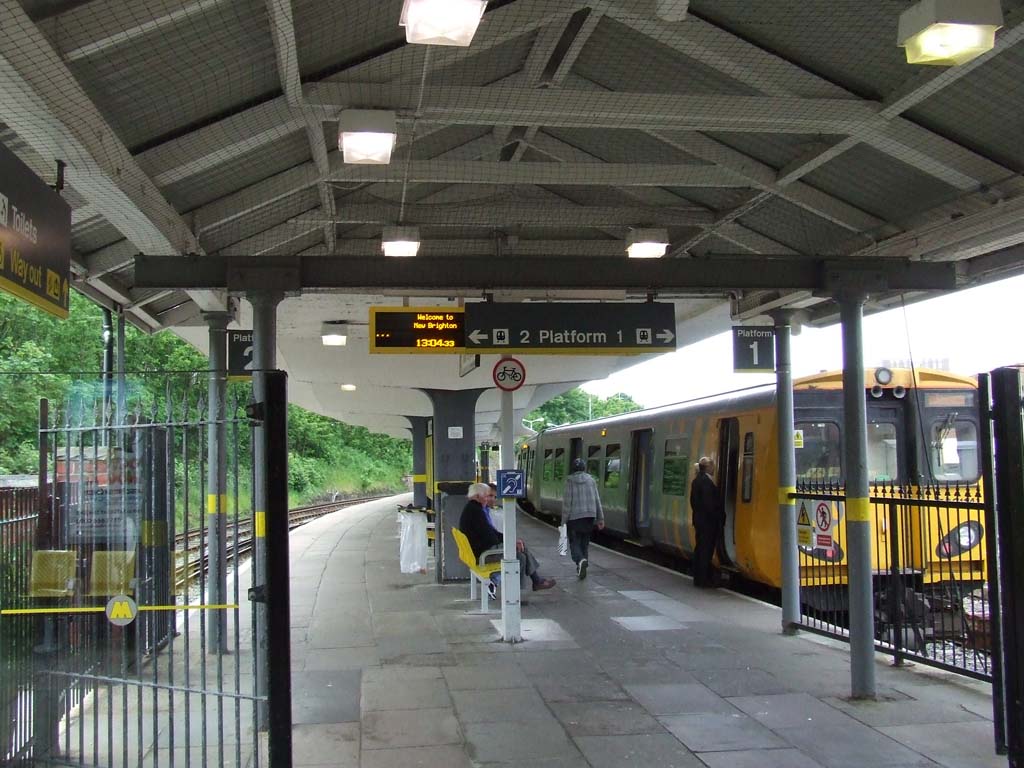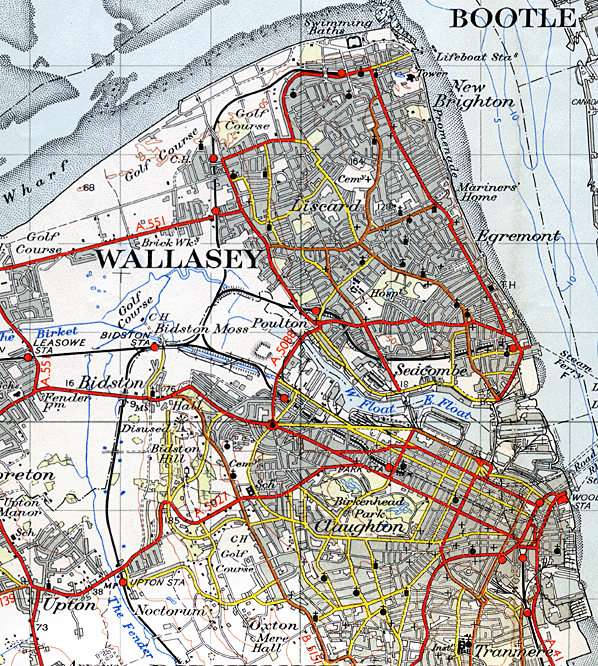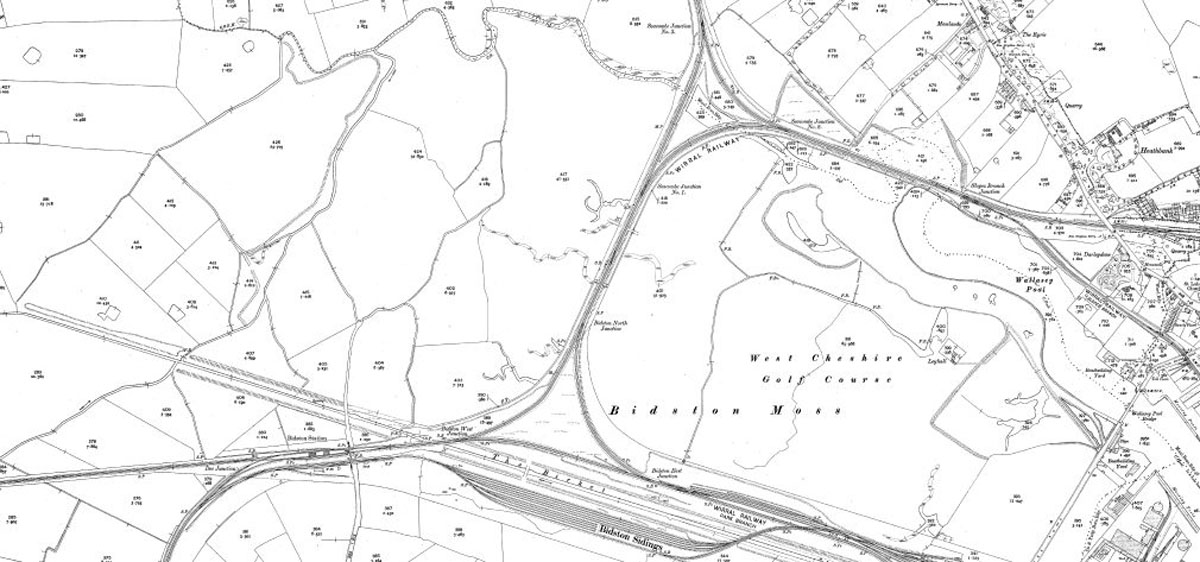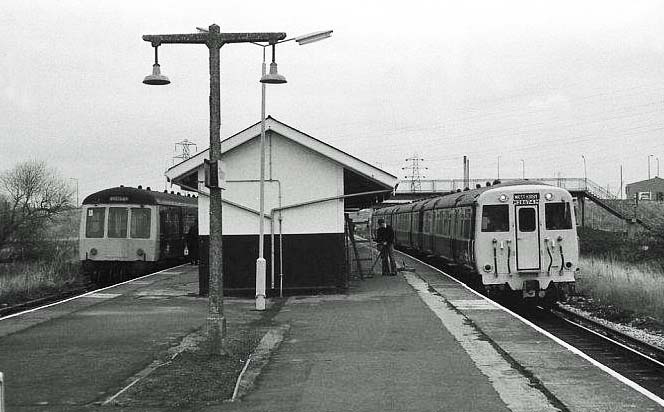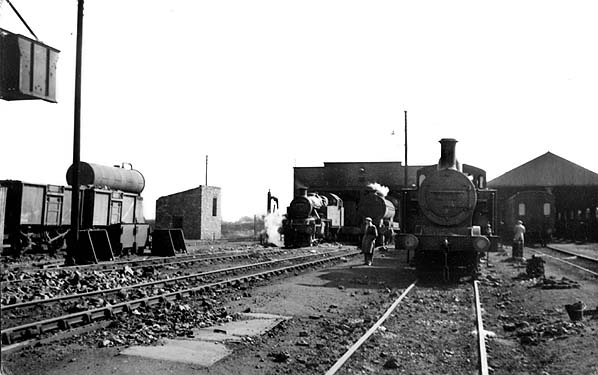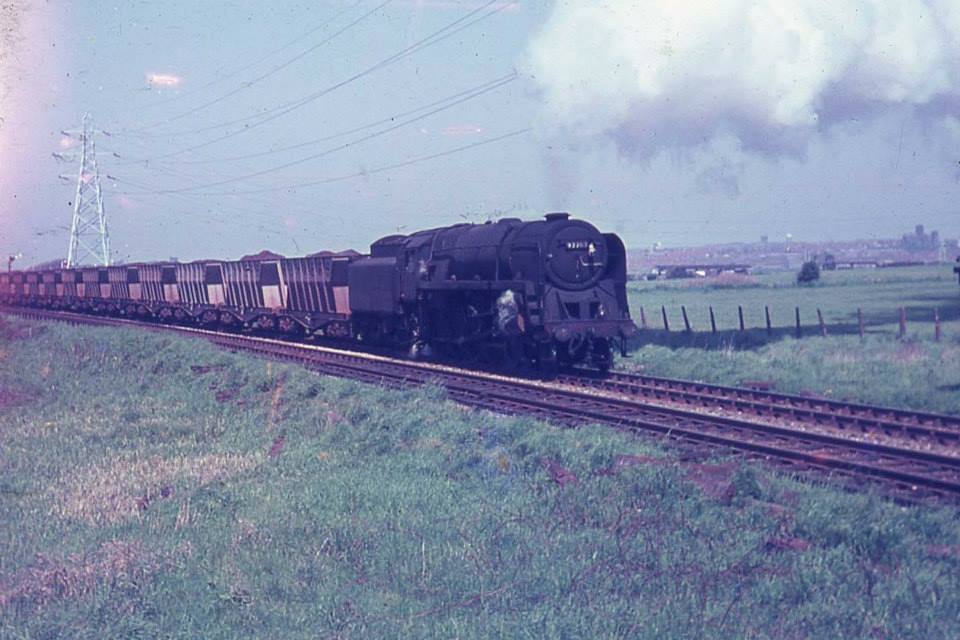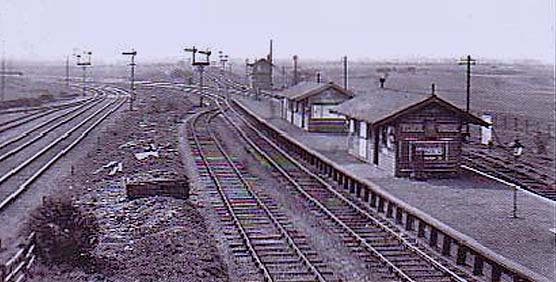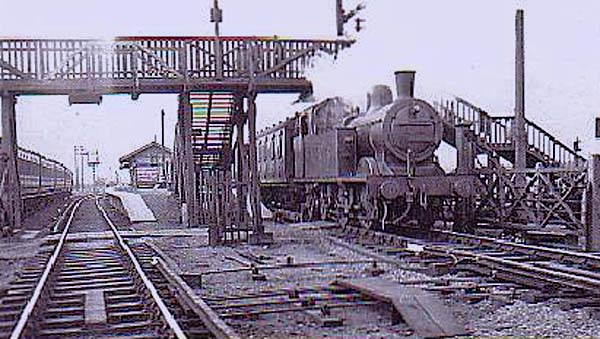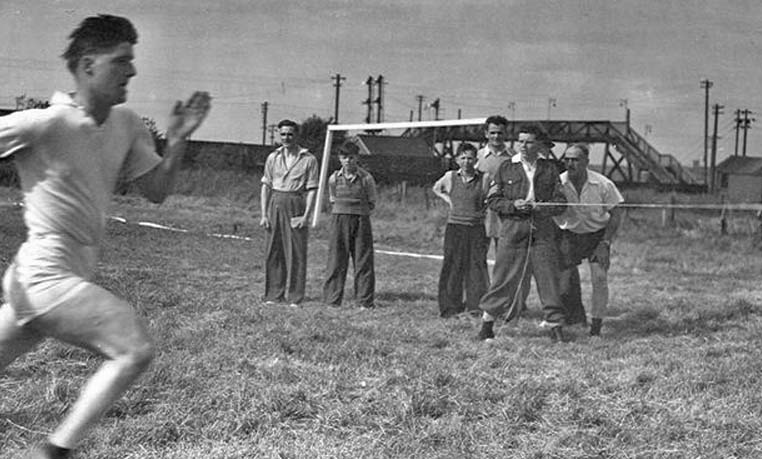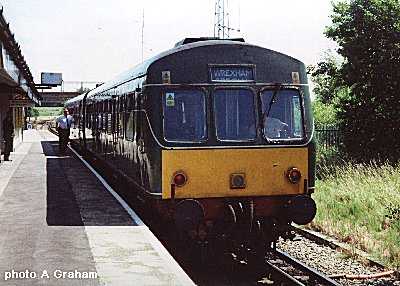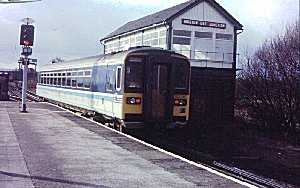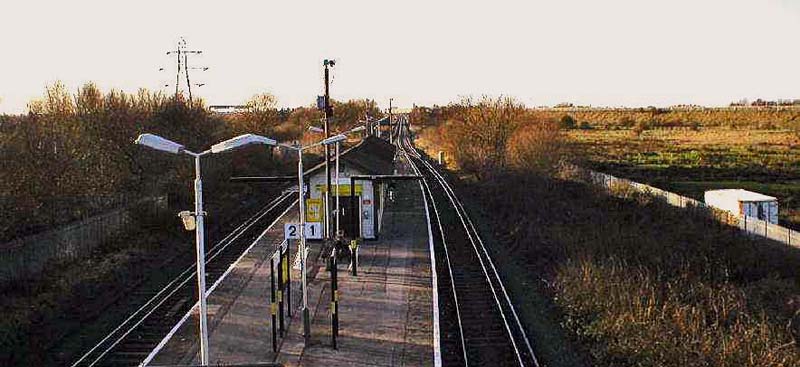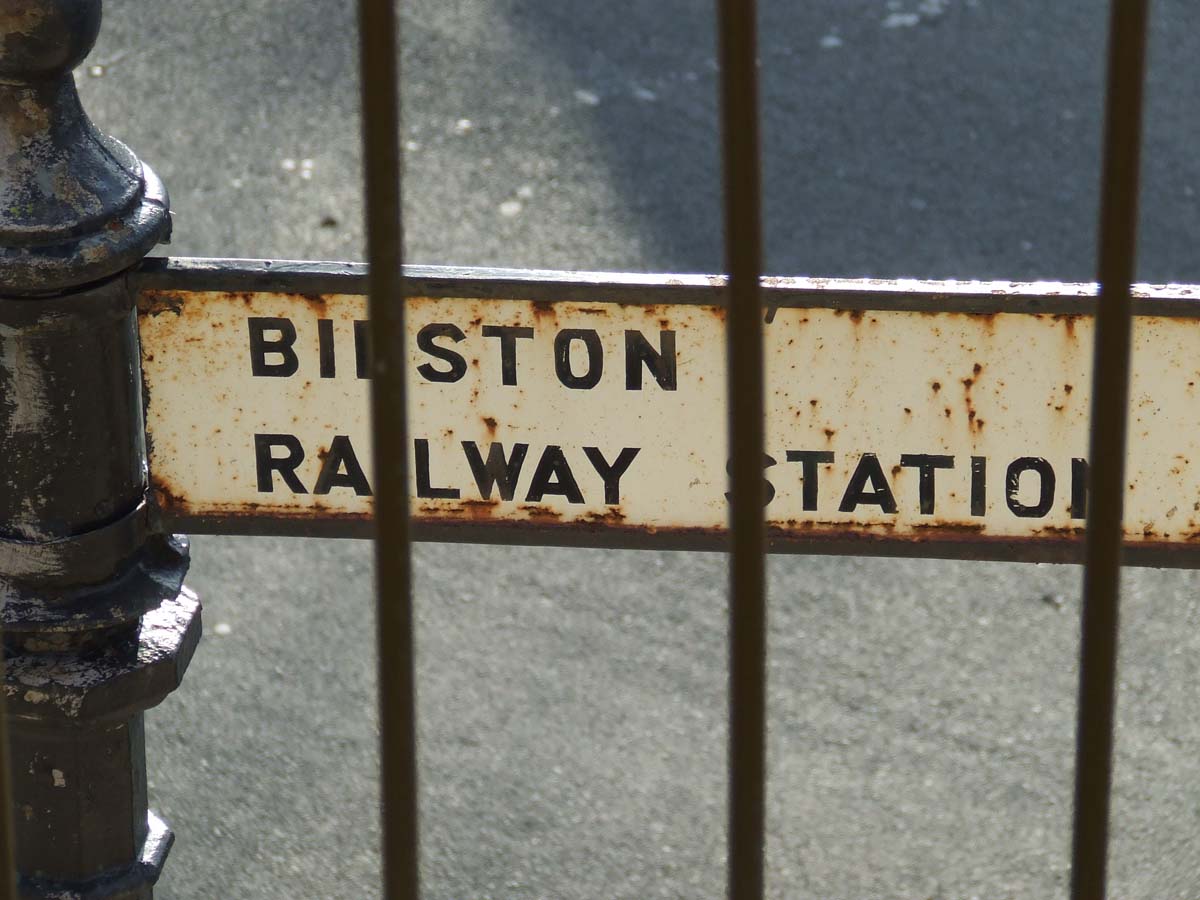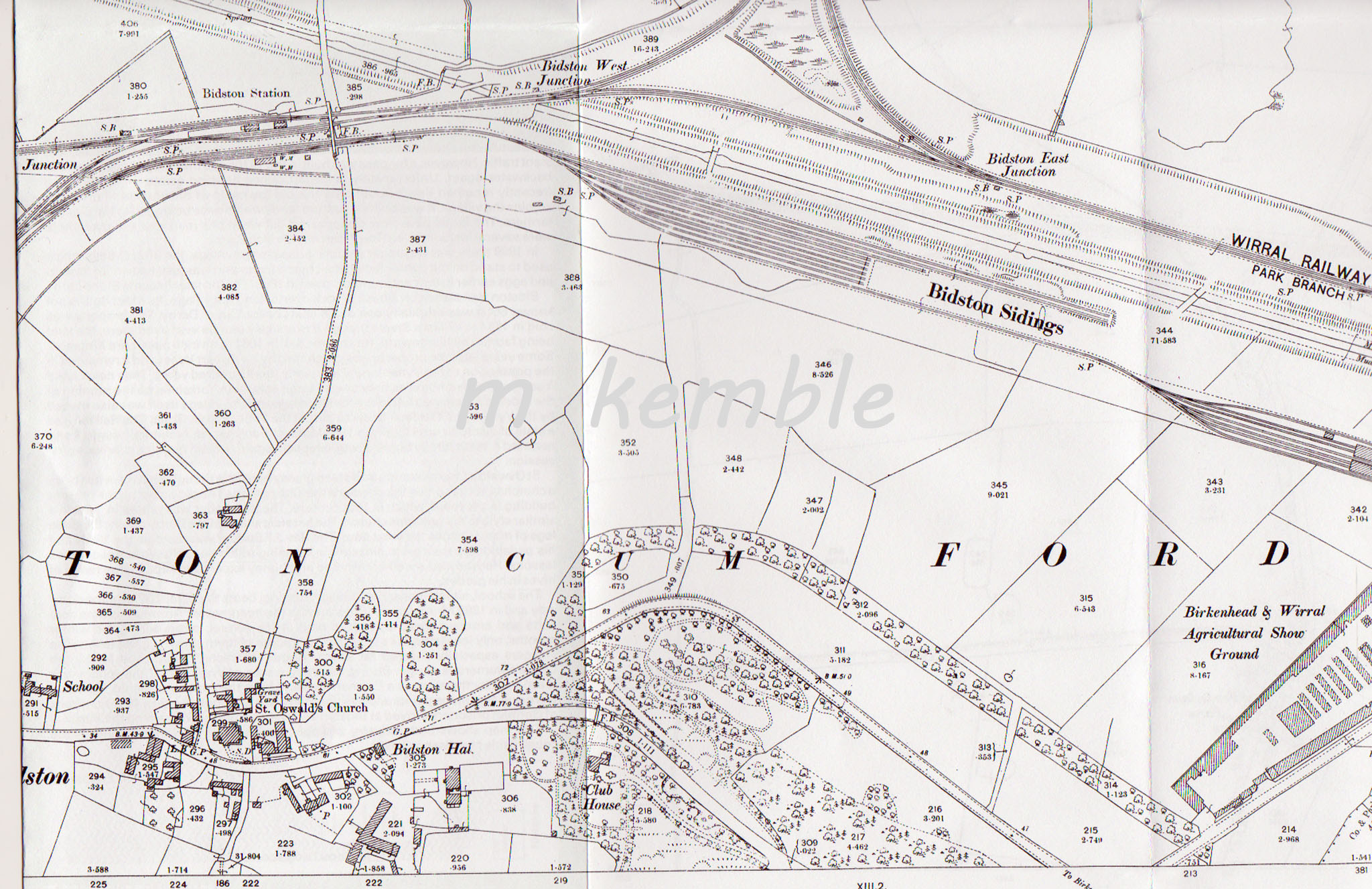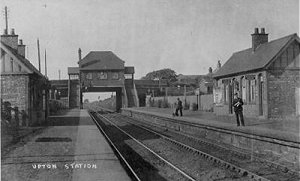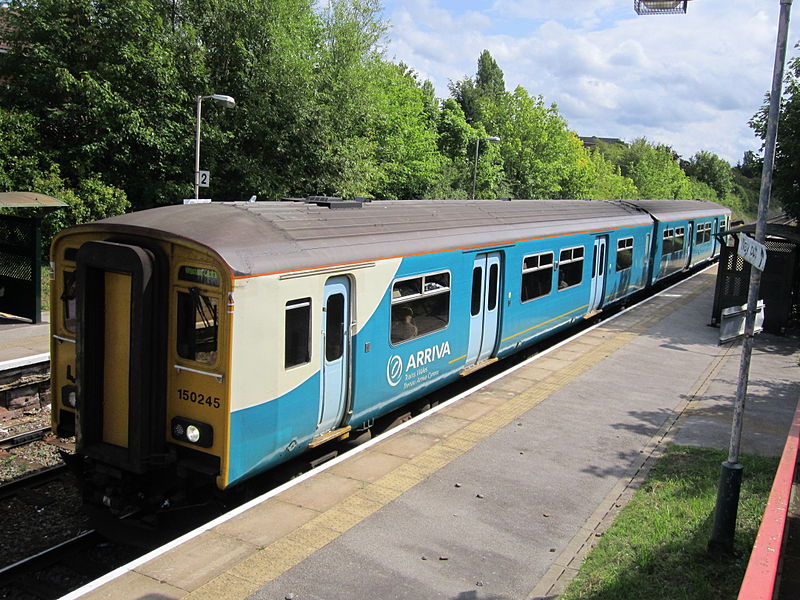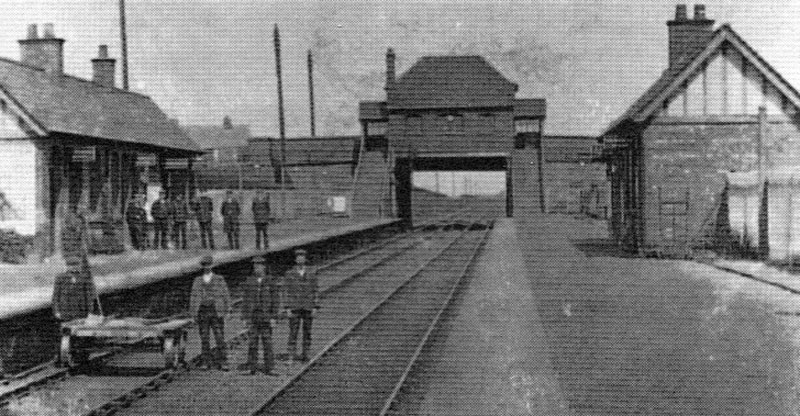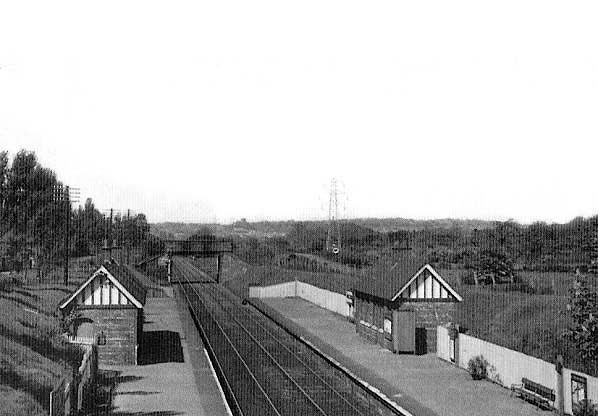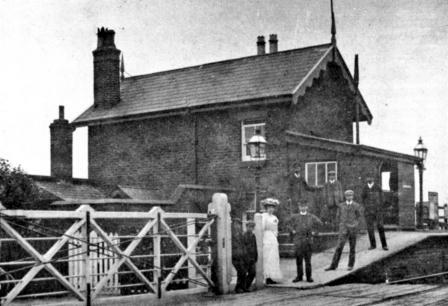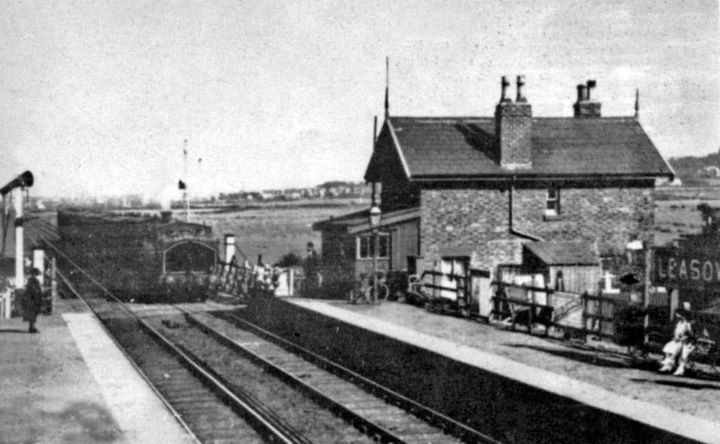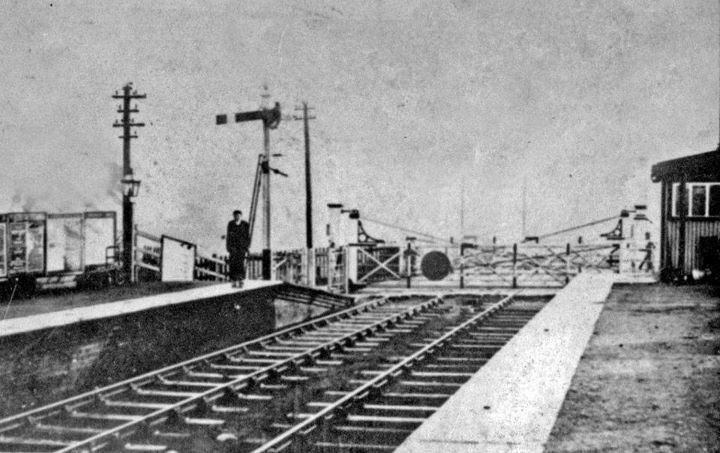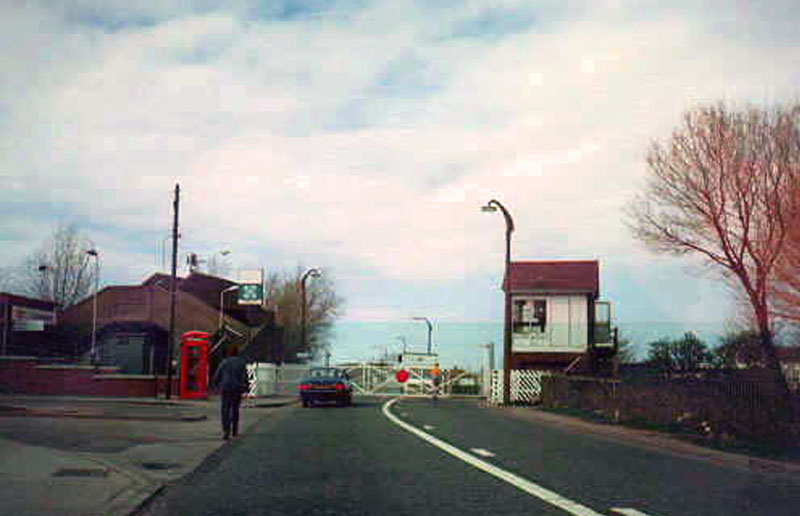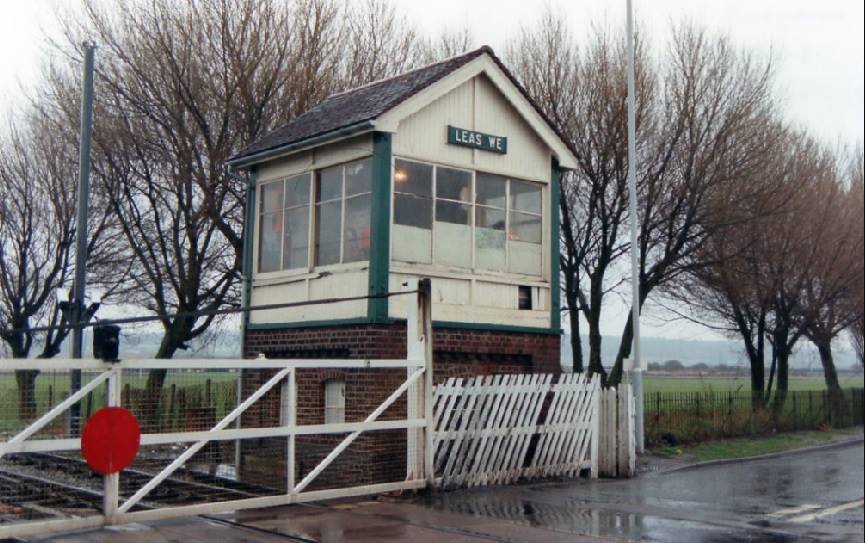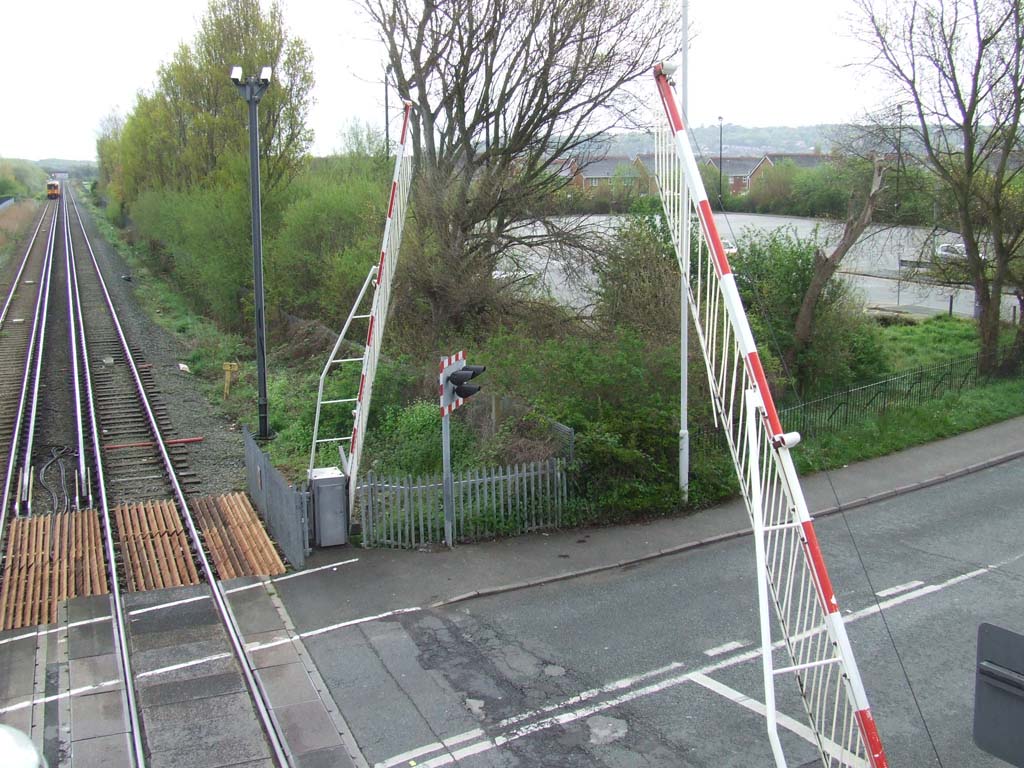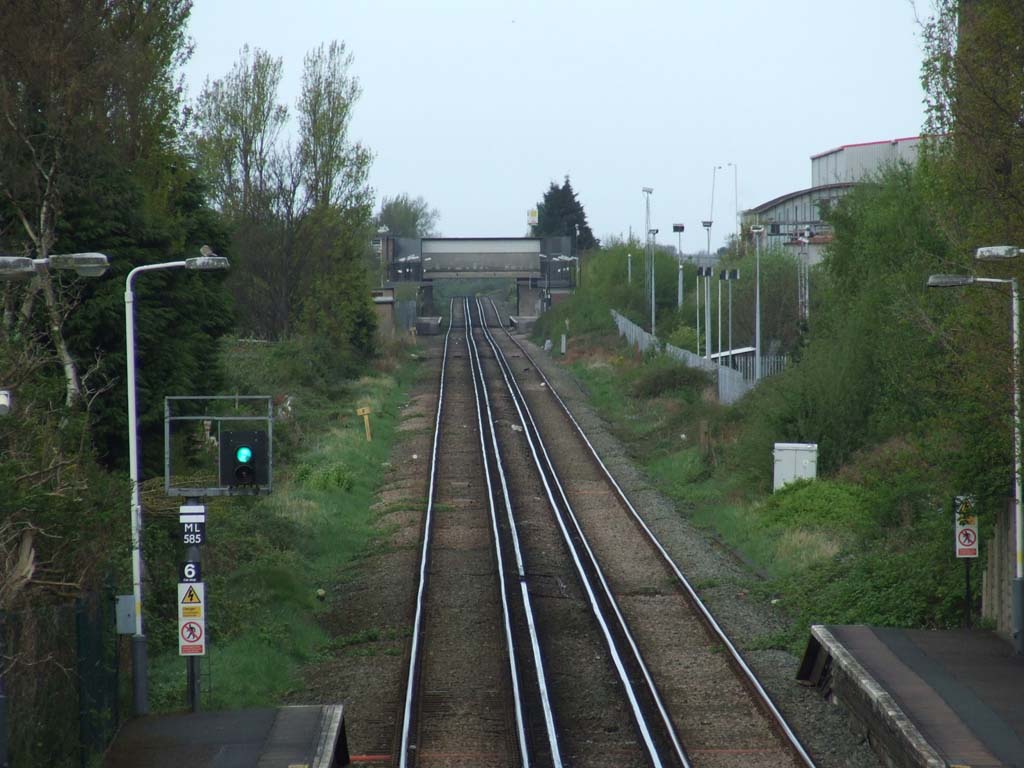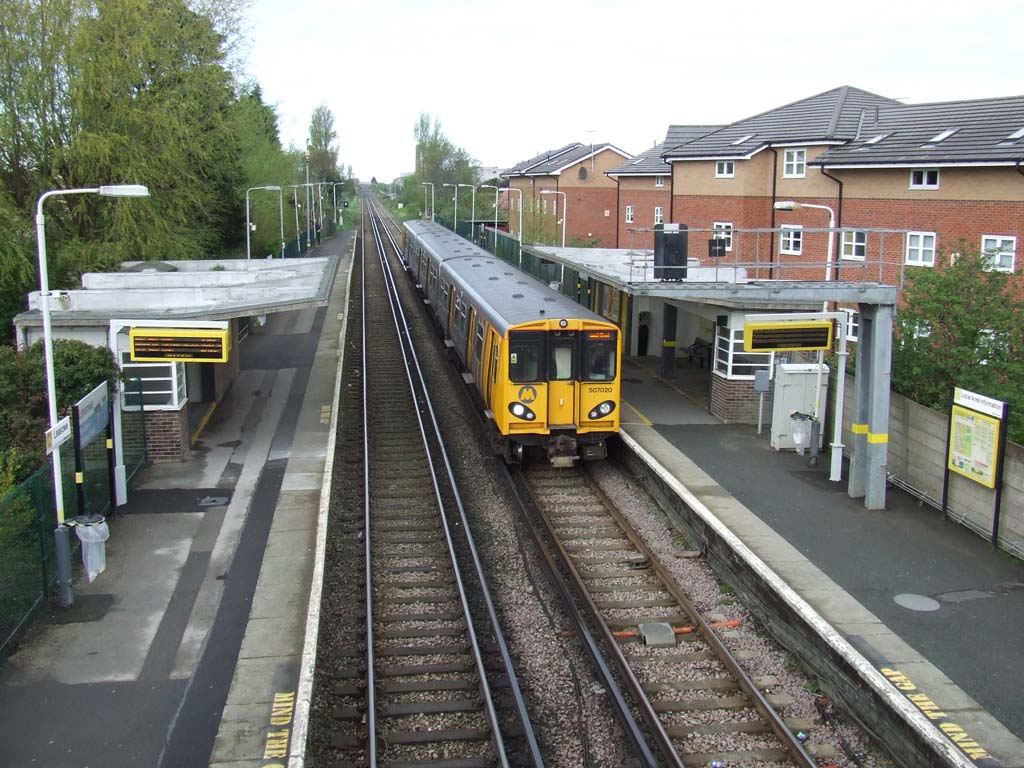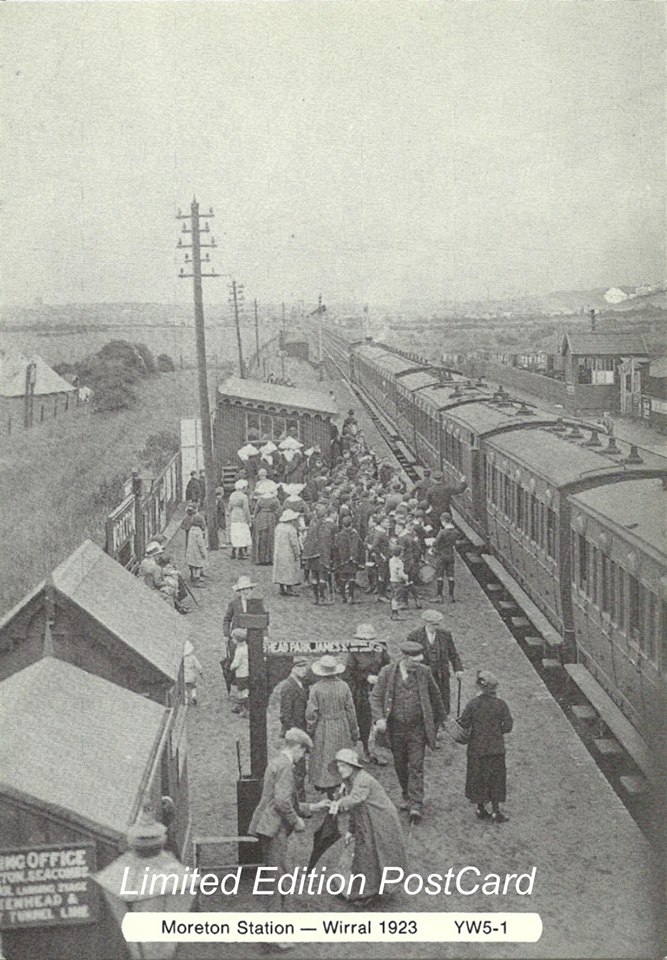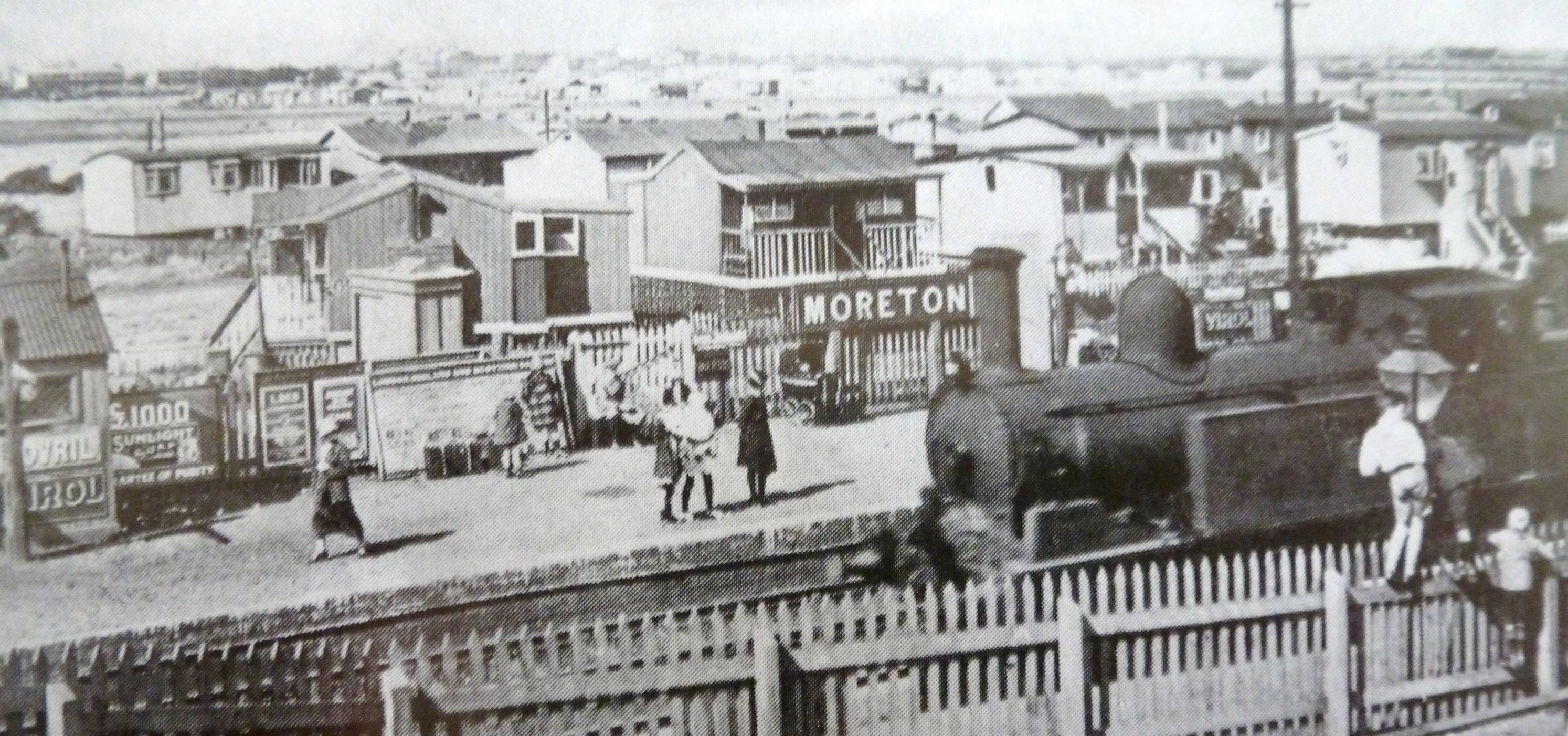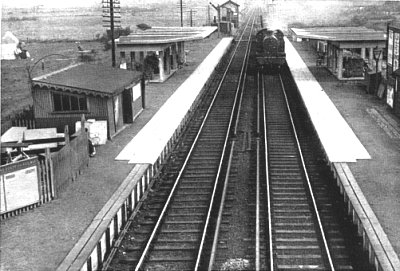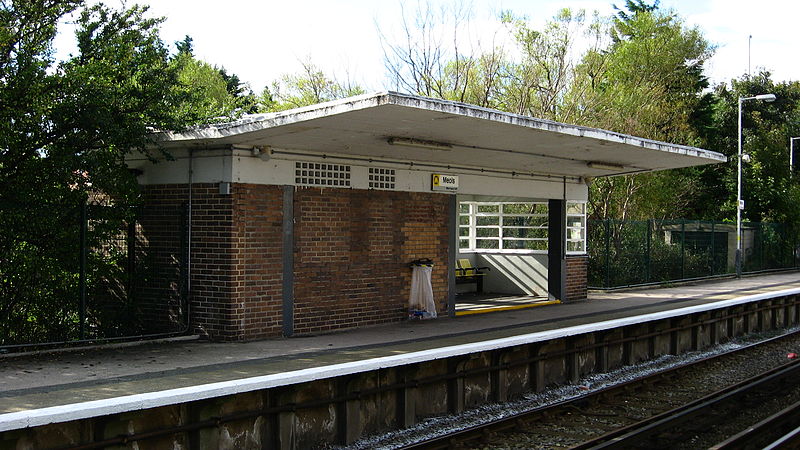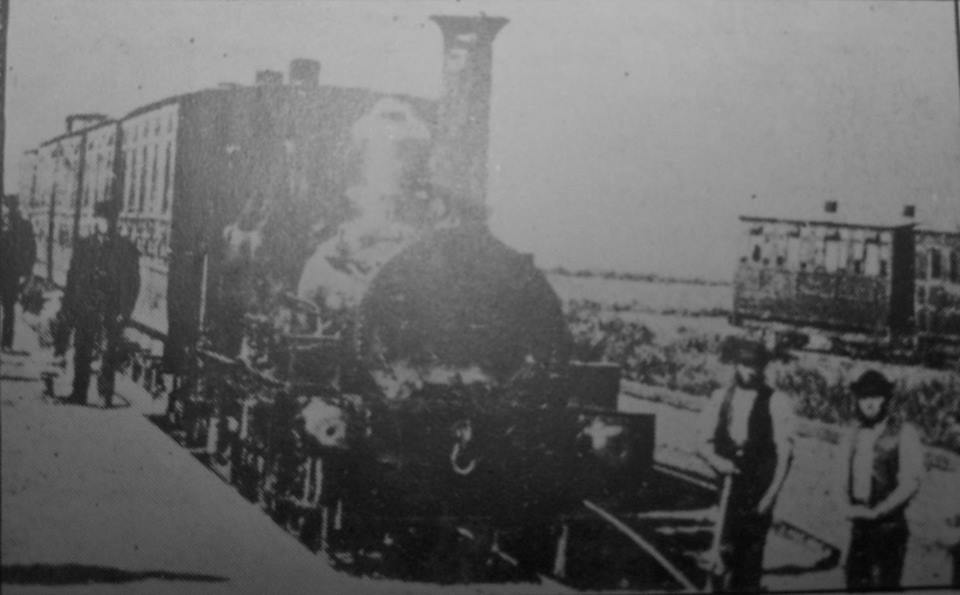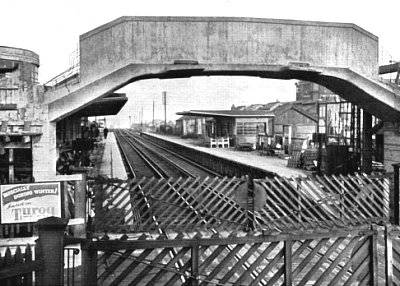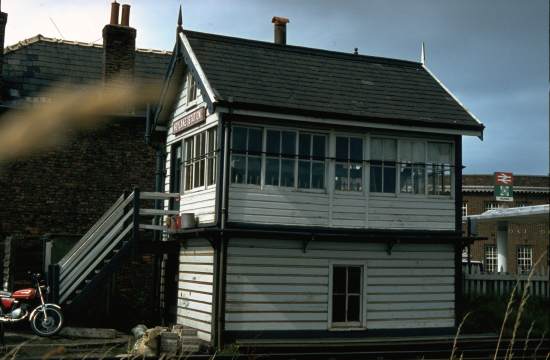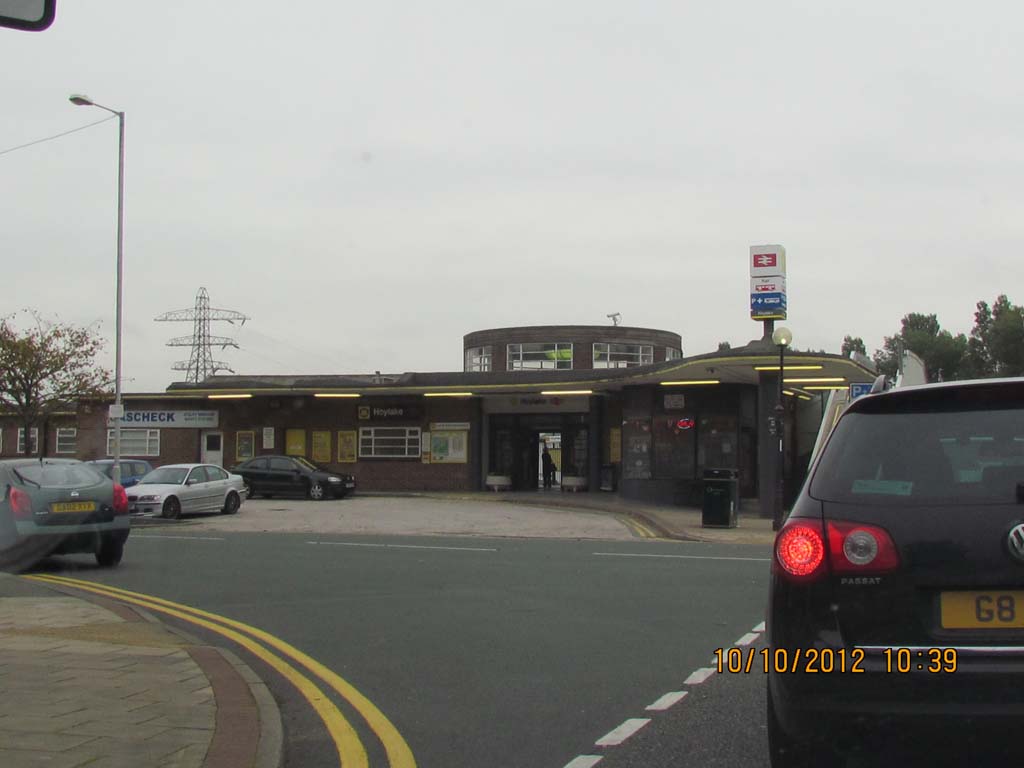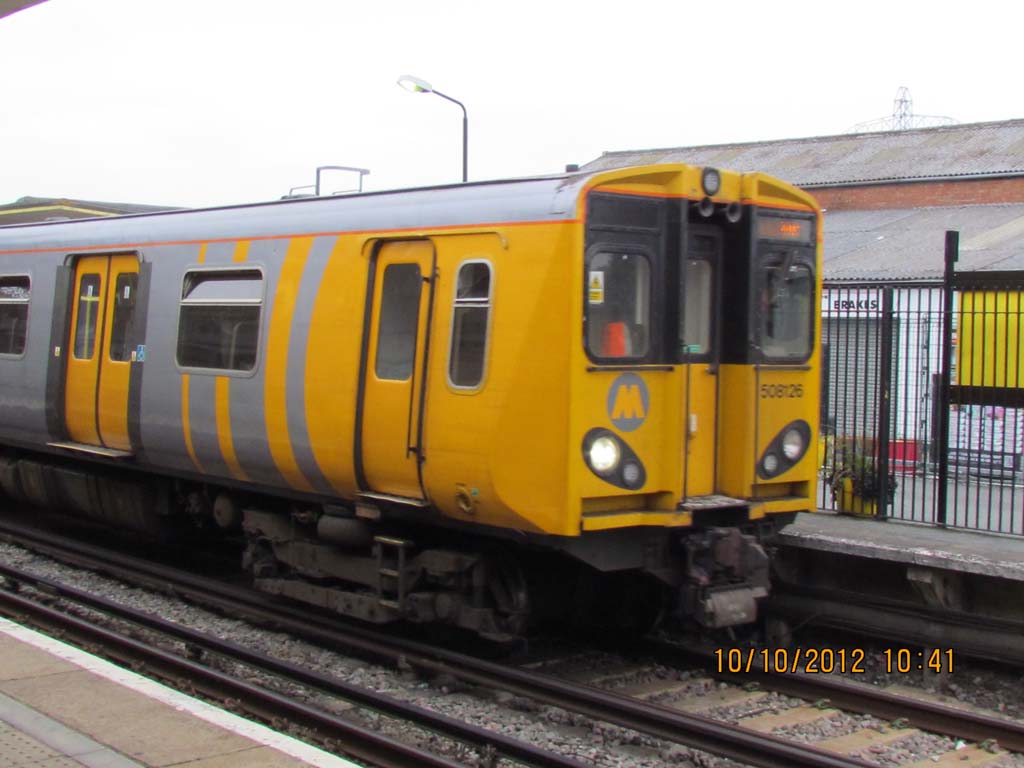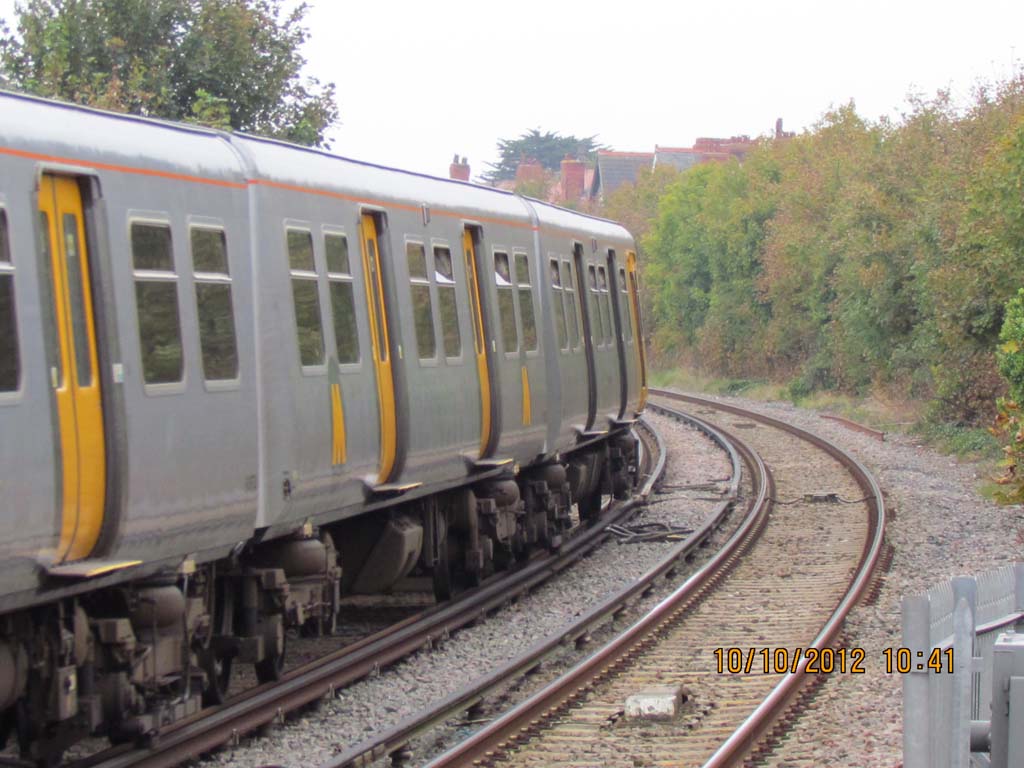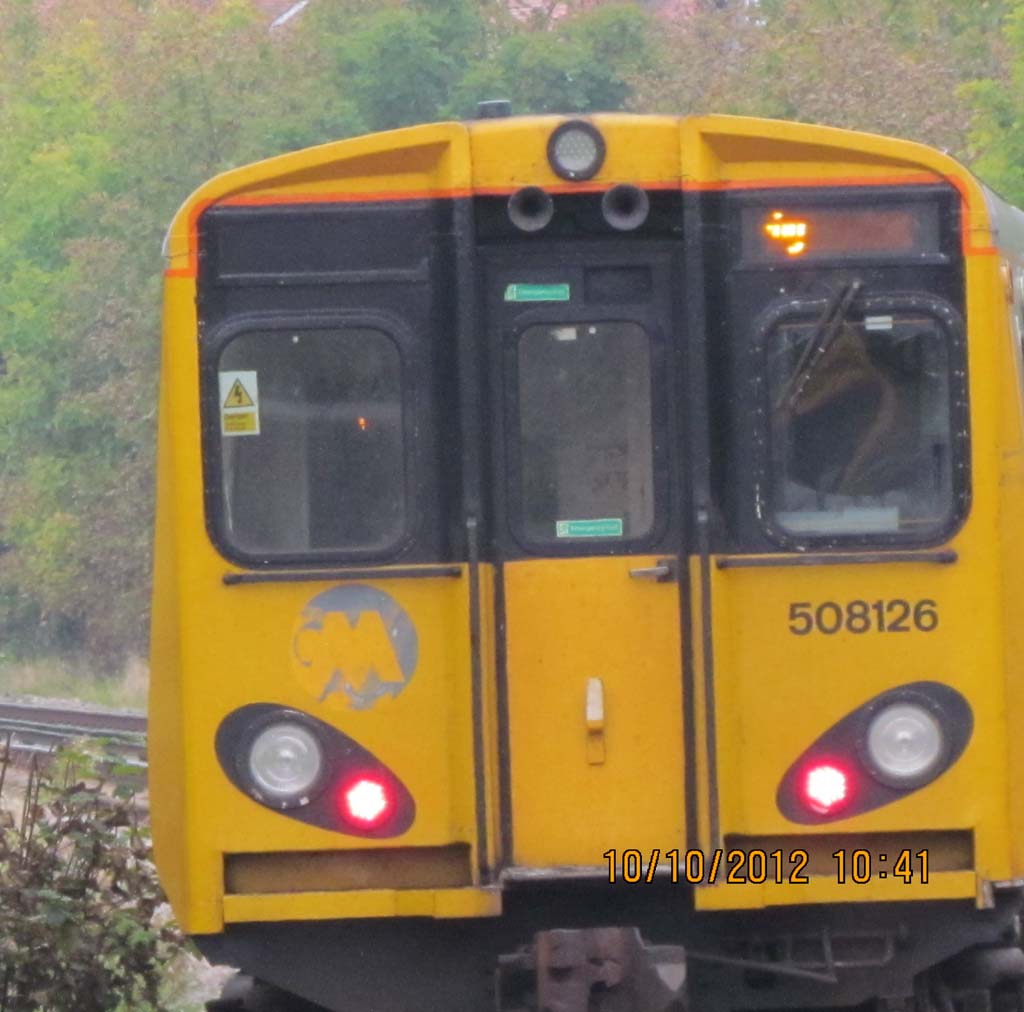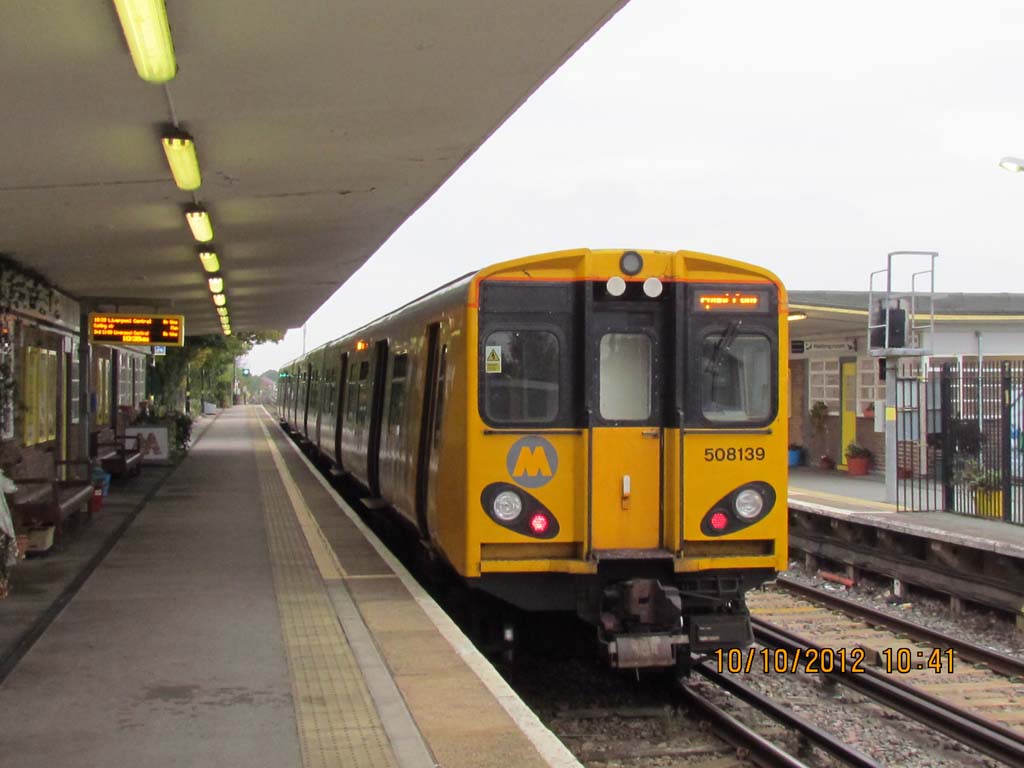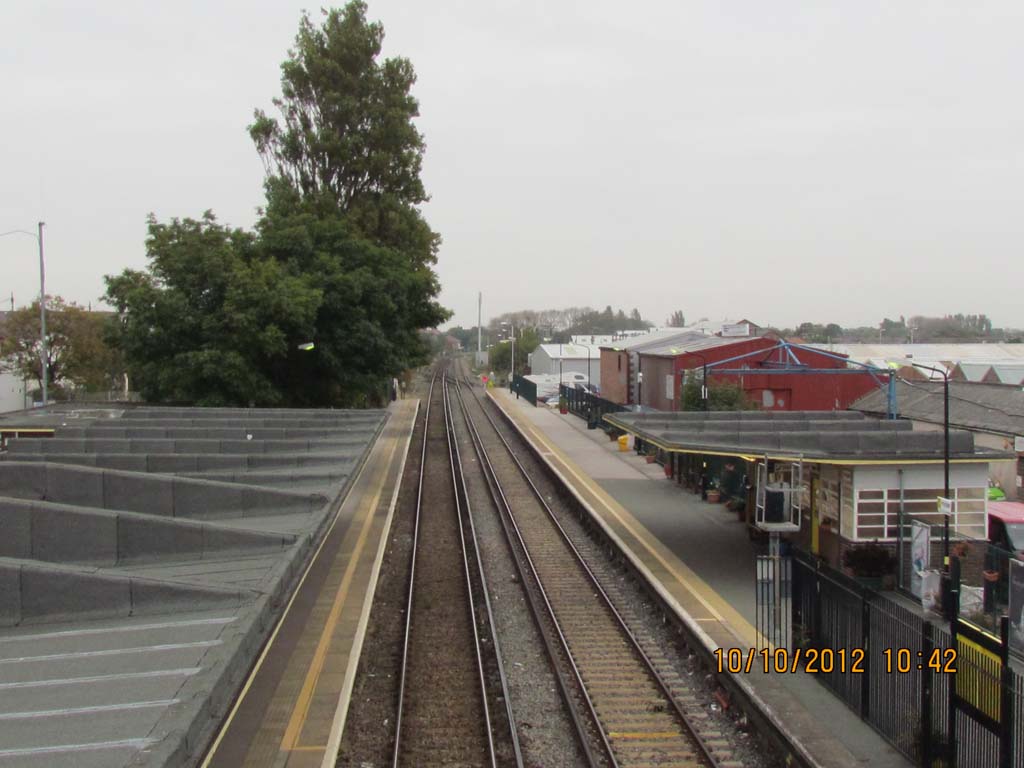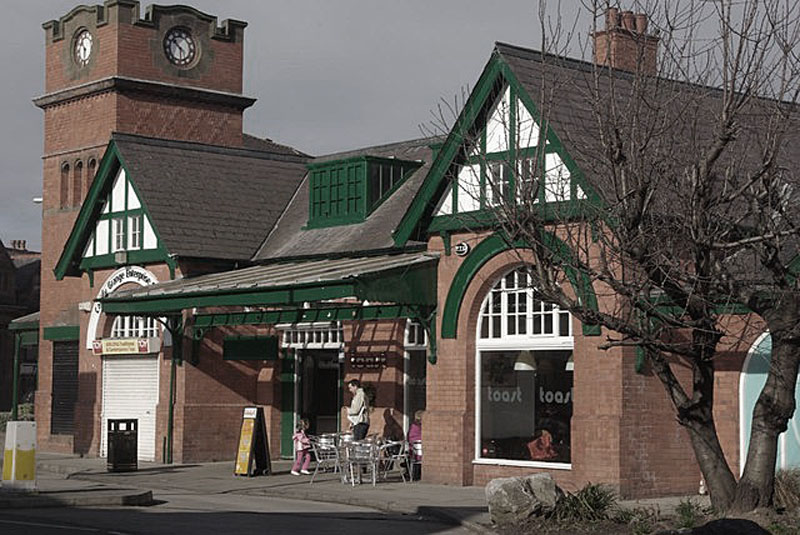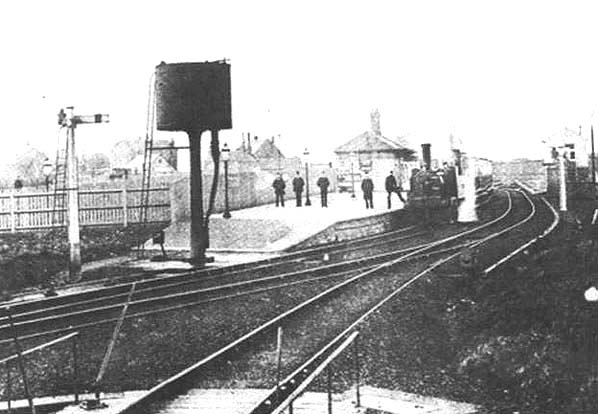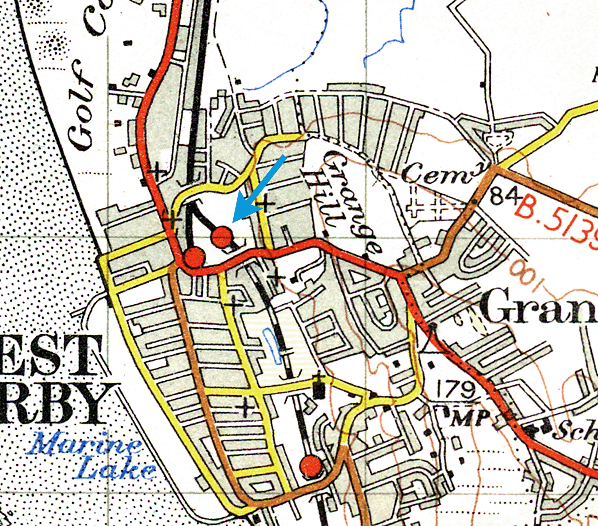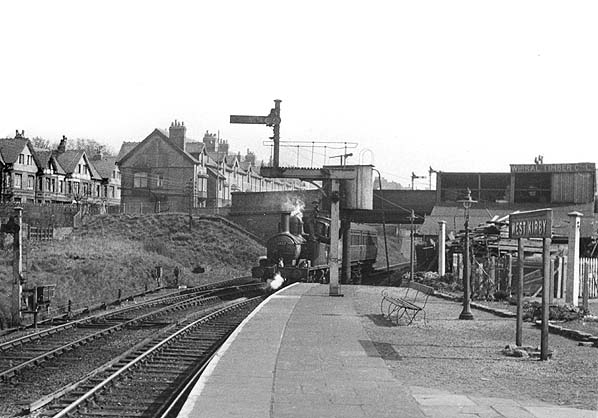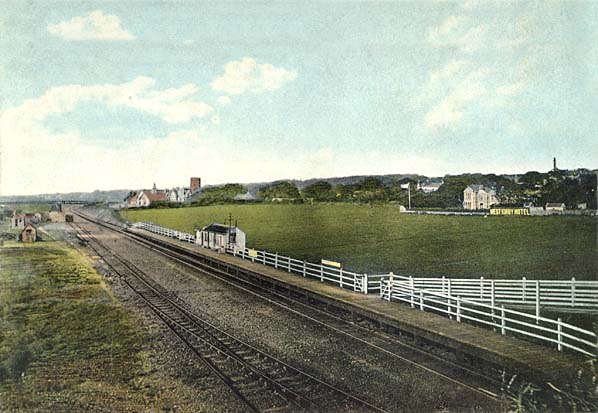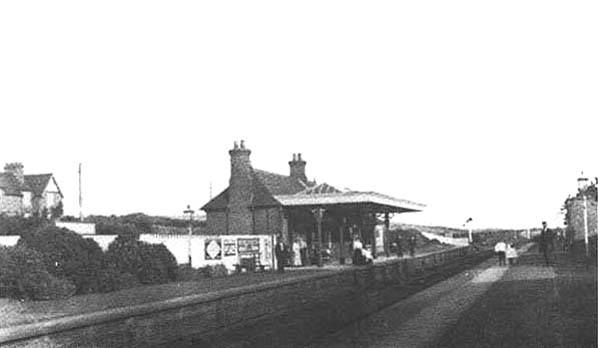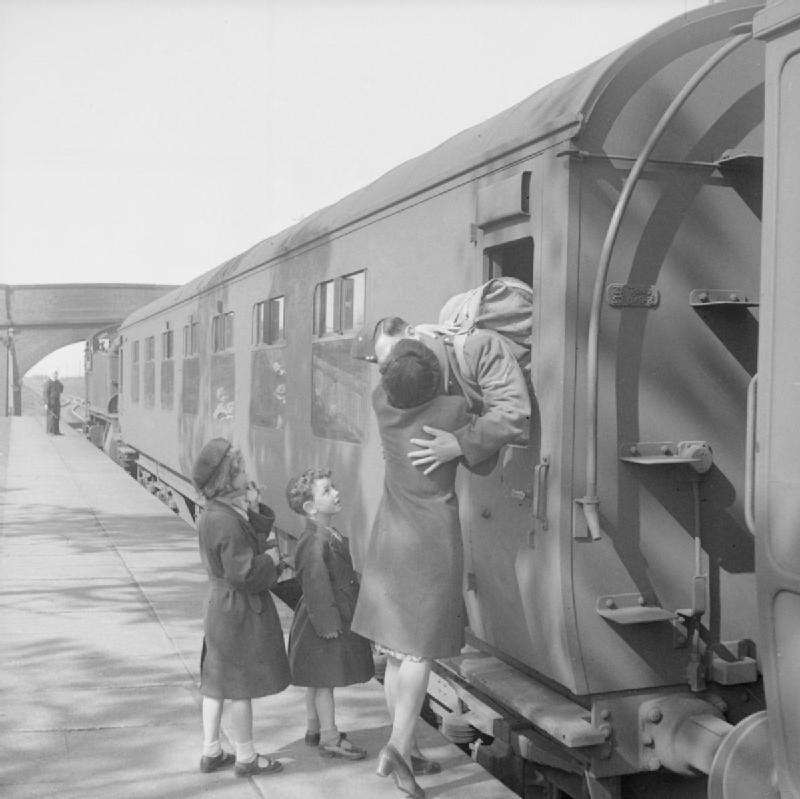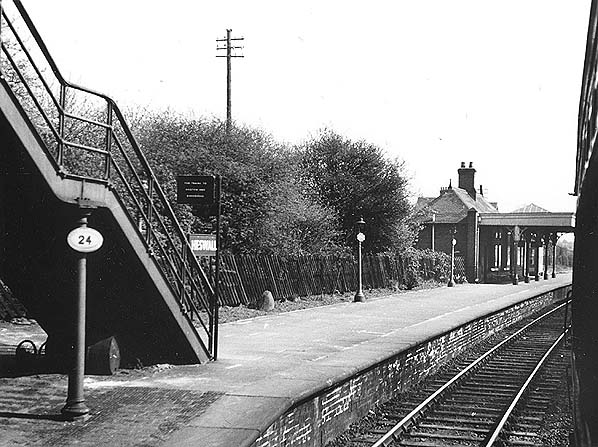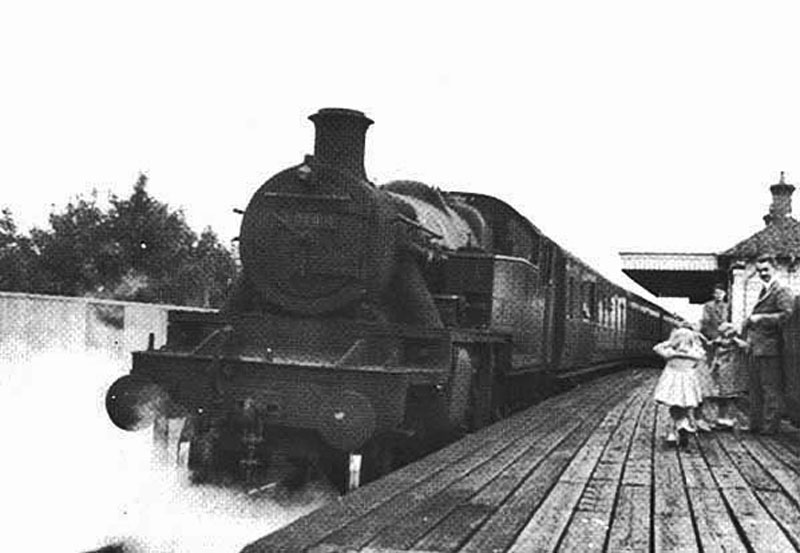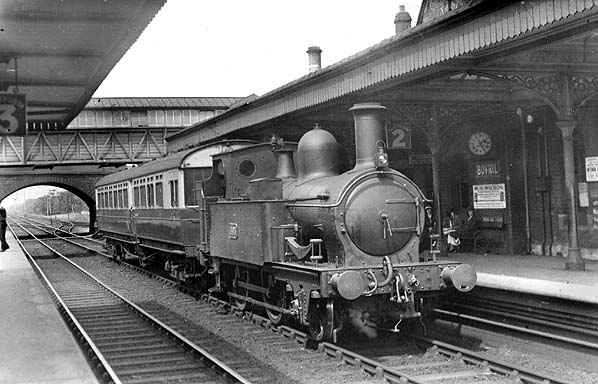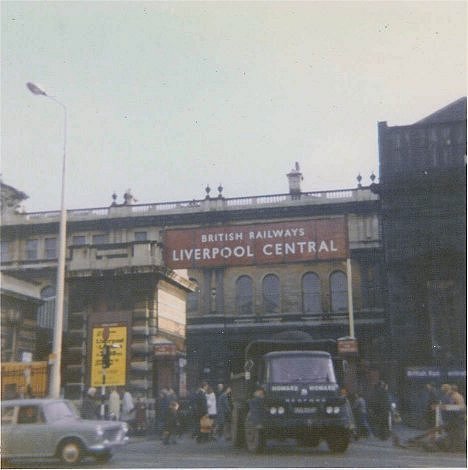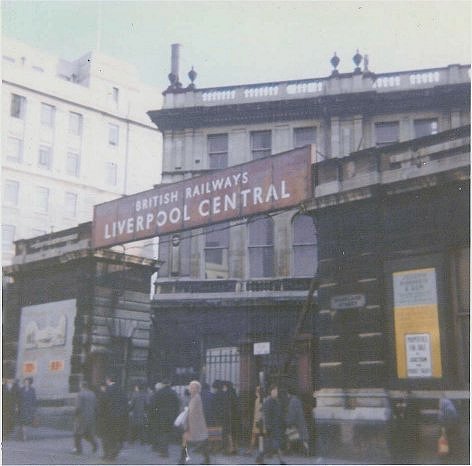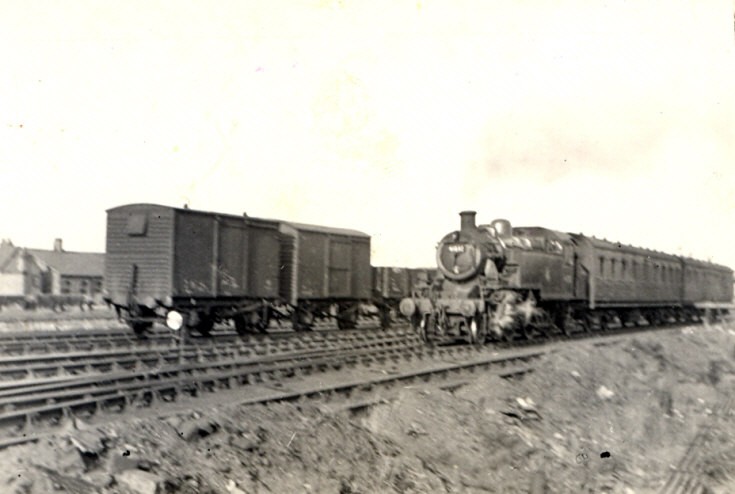|
Railways Stations on North Wirral I have only included the stations in a square of the Wirral from Port Sunlight across to Kirby Park, up to West Kirby and across to New Brighton, down again to Rock Ferry & Bebington. I start the journey from Woodside, then across the road to Hamilton Square, branching off to Port Sunlight, then back along to Birkenhead North, and then Seacombe and Wallasey to new Brighton before returning to the West Kirby line. Birkenhead Woodside Birkenhead Woodside railway station was opened on 31 March 1878 to replace the increasingly inadequate passenger facilities provided at Birkenhead Monks Ferry Station. it was built further inland than originally conceived, in order to avoid demolition of the Mersey ferries workshop, situated on the bank of the river. The station was a grandiose building, with two semi cylindrical roofs covering much of the platforms. However, given the size of the station, it only had five short (but wide) platforms, as much of the space was taken up by middle tracks and a roadway. The station building was known to local rail users as "the wrong way round", because for the majority of the station's life, its original rear entrance was used as the main booking hall, whereas Woodside's 'front' entrance was mainly used for handling parcels. This entrance, covered in a porte-cochere to allow travelling gentry to avoid inclement weather, faced the graving dock on the south side of the station. It had been intended that passengers disembarking from the nearby ferry terminal of the same name would use this entrance. Unfortunately, the ferry companies were slow at co-operating and when the tram terminus opened in front of the ferry terminal in the early 1900s, the decision was made to keep the small 'back' entrance a permanent fixture. This was very unfortunate, as passengers arriving at the station never got to see the huge sandstone fireplaces, decorative brick work and massive timber roof trusses holding up the roof of the intended booking hall. Trains ran from here to West Kirby, Chester, Warrington & North Wales. They also ran to Chester General, Shrewsbury, Wolverhampton, Birmingham Snow Hill and Paddington, London. In spite of the fact that the station was a very busy station, it was axed in the Beeching rout of railway lines. In early 1967, 6 through trains to Paddington on weekdays but, by March, they stopped at Wolverhampton. The final service remaining was the hourly service to Chester. I Nov these too stopped, at Rock Ferry. The station closed on 5th November 1967 and all that remains today is part of the outer wall, a road bridge and a tunnel. It is now a bus park. The fabulous station gates are now fronting a Gayton house near Heswall.
Hamilton Square Hamilton Square, an underground railway station, was opened on 1 February 1886. The Mersey Railway was electrified in 1903, as despite the journey being far quicker than travel aboard the Mersey Ferries passengers were not keen on travelling underground due to the smoke from coal-powered steam locomotives. A "Frequent electric trains" sign was erected on the outside of the station's large hydraulic lift tower (slightly below the position of the present sign) to publicise these cleaner trains. In the 1970s, as part of the expansion programme of the Merseyrail network, a burrowing junction was built at Hamilton Square so that trains heading towards New Brighton and West Kirby did not have to cross the path of trains coming from Rock Ferry on the flat crossing. Along with the construction of the loop tunnel in the centre of Liverpool, this improved the capacity of the Wirral Line, allowing increased train frequencies. As part of this project, Hamilton Square gained a new platform (Platform 3) for New Brighton and West Kirby services, and the rest of the station was refurbished
Birkenhead Central (Rock Ferry Line) Birkenhead Central station was opened in 1886 as part of the Mersey Railway's route from Liverpool, via the Mersey Railway Tunnel under the River Mersey. The station was also the location of the Mersey Railway's headquarters.
Green Lane (Rock Ferry Line) Green Lane railway station serves the town of Birkenhead, Wirral, England, this is located in the south of the town. It is situated on the Chester and Ellesmere Port branches of the Wirral Line, part of the Merseyrail network. The station was opened in 1886 as the terminus of the Mersey Railway's line from Liverpool via the Mersey Railway Tunnel. In 1891 the line was extended southwards to Rock Ferry, and was subsequently electrified in 1903. It became part of the British Rail's Merseyrail network in the 1970s. Further electrification in the 1980s and 1990s allowed train services to be extended beyond Rock Ferry; first to Hooton in 1985, then to Chester in 1993 and finally Ellesmere Port in 1994. Trains operate every 15 minutes between Chester and Liverpool on weekdays and Saturdays until late evening when the service becomes half-hourly, as it is on Sundays. Additionally there is a half-hourly service between Liverpool and Ellesmere Port all day, every day. Northbound trains operate via Hamilton Square station in Birkenhead and the Mersey Railway Tunnel to Liverpool. Southbound trains all proceed as far as Hooton, where the lines to Chester and Ellesmere Port divide.
Monks Ferry Monks Ferry opened on 23/10/1844. The station was located at the end of a single track tunnel that ran to the site of Grange Lane where a new station Birkenhead Town was provided. Monks Ferry Station was Merseyside's first riverside station and it was connected to Liverpool by a ferry service. The' station was originally provided with two platforms which were protected from the elements by an overall roof. On the 22nd July 1847 Monks Ferry became part of the Birkenhead, Lancashire and Cheshire Railway who doubled the track between Birkenhead Town and Chester. On the 1st of August 1859 the company simplified its name to the Birkenhead Railway. The following year it was taken over by the GWR and LNWR as a joint line. By the 1870s Monks Ferry had become far too small for the traffic levels that the line was carrying and it was replaced on the 31st March 1878 by a new terminus that was opened at Birkenhead Woodside. From this date Monks Ferry closed as a passenger station. The station was not closed completely however as it was used for many years as goods depot. Today the site is occupied by apartment blocks and the only evidence of the station ever having existed is a sandstone wall which formed part of an over bridge at the west end of the station. Closed in the 1960s.
Monks Ferry station was located on the west bank of the River Mersey on
the southern edge of Birkenhead. The main entrance to the station was on
the south side and was reached via Monks Ferry Brow which connected the
ferry landing point to Church Street. Church Street passed over the line
on a bridge at the west end of the station. The main facilities were
housed within a single-storey building on the south side of the station.
They consisted of two booking offices, one on either side of the main
entrance foyer, a cloak room, stationmaster’s office, refreshment rooms,
toilets and waiting rooms for both sexes, a lamp room and general
storage rooms.
Grange Lane Grange Lane, as a station, did not last very long and almost missed history altogether. It was not the forerunner of Birkenhead Town as thought, but was a totally separate entity. Birkenhead Town was built on the site but at a much later date and long after Grange Lane had vanished. Grange Lane was opened in 1840, on 23rd September.
Birkenhead Town The first railway to reach Birkenhead was the Chester and Birkenhead Railway who opened a temporary terminus at Grange Lane on 23.9.1840. Four years later the line was extended to a new terminus on the Mersey river bank called Monks Ferry which opened on 23.10.1844. The original terminus at Grange lane closed and a new station opened only metres to the east. This station was Birkenhead Town. In some early timetables the station was shown as Birkenhead Town Grange Road. The station was located at the end of a single track tunnel that ran to Monks Ferry. On 31.3.1878 a new terminus was opened at Birkenhead Woodside which necessitated some alterations to Birkenhead Town. It still lay at the entrance to a tunnel. The station was an early closure closing on 7.5.1945. The line continued in use until the closure of Woodside in 1967 after which the tracks were lifted. Today the site is lost amongst a complicated array of approach roads to the Birkenhead - Liverpool road tunnel. However behind the advertising hoarding remnants of the ticket office with its glazed brick can still be seen. Also visible are the tunnel mouths of the Woodside and the Monks Ferry Tunnels although both are partly filled in. After closure the building remained standing for many years having found other uses. It's date of demolition is not known.
Tranmere Station Tranmere was a railway station on the Chester and Birkenhead Railway in Cheshire, England. It opened in 1846 and closed in 1857 and consisted of two platforms (only one up to 1847). It originally opened as Lime Kiln Lane and was later renamed as St. Paul's Road, finally changing to Tranmere in 1853. On 22 July, 1847, the railway became part of the Birkenhead, Lancashire and Cheshire Junction Railway. The company doubled the track, which up to this time had been single track. This is the most likely time for the second platform to have been added. in 1891, the Mersey Railway opened a double track extension, and at the same time, the Birkenhead and Chester line was quadrupled, destroying any evidence of the station site. A very short lived station that did not even appear on any ordnance survey maps. There is a bridge on St Pauls Road that was adjacent to the station. The station was situated at the top of this line by the far yellow gradient sign
Rock Lane Rock Lane station opened in June 1846. The station was situated on the Chester and Birkenhead Railway Company's Birkenhead to Chester line which had opened on the 23rd September 1840. At the time when Rock Lane station opened the Birkenhead to Chester railway was a single track line so it is likely that it was provided with only one platform. The station was in a cutting on the south side of an overbridge that carried Rock Lane West over the line. Trains serving the station would have run between Birkenhead Monks Ferry, Chester and points to the south of Chester. On the 22nd July 1847 the line became part of the Birkenhead, Lancashire and Cheshire Junction Railway and shortly afterwards the new company doubled the track between Birkenhead and Chester. It is likely that at this time Rock Lane would have gained an extra platform. In 1859 the owning company changed their name to the Birkenhead Railway but by November 1860 the company was taken over by the GWR and LNWR who operated the line as joint concern. On the 31st October 1862 Rock Lane Station closed. It was replaced by a new station, situated a short distance to the north, called Rock Ferry. It is interesting to note the ticket above is dated 4th November 1863, a year after the station closed. Between 1900 and 1905 the line through the site of Rock Lane station was quadrupled. This destroyed all traces of the station. Photo: Paul Wrightt http://www.disused-stations.org.uk/r/rock_lane/index.shtmlhttp://www.disused-stations.org.uk/r/rock_lane/index.shtml
Rock Ferry
Bebington & New Ferry The station was renamed from Bebington & New Ferry to Bebington on 6 May 1974. The station is on the former Chester and Birkenhead Railway, which opened in 1838. Direct electric trains to Liverpool began in 1985 with the electrification of the line from Rock Ferry to Hooton. Passengers before this had to change at Rock Ferry.
Port Sunlight Port Sunlight station is on the Chester to Liverpool line which was opened in 1838. It was electrified in 1985 before which passengers had to change at Rock Ferry.
Spital
Conway Park (West Kirby & New Brighton Line) Conway Park is the newest station on the Wirral Line, opening on 22 June 1998. The name has come under criticism as some regard it not to be particularly indicative of the station's location. When it was originally being planned, the station was known as Birkenhead Market. It was built by excavating a box downwards, opening out the roof of the tunnel, which is 18 metres below ground level.
Park Station (West Kirby & New Brighton Line) This was opened on 2 January 1888. As a joint station between Wirral Railway and Mersey Railway. The station originally being called Park Joint Station. In December 1922 a collision between an upbound West Kirby train and a downline West Kirby train killed one person and injured 12. This was the only accident involving loss of line in the history of the Wirral Railway. In 1938 the need for people to change here was removed and trains ran directly to Liverpool. The station then became Birkenhead Park.
Birkenhead North (West Kirby & New Brighton Line) This was opened in 1866 and originally known as Birkenhead Docks. Becoming part of LMS it was renamed Birkenhead North in 1926. The line was electrified in 1938
From here the line splits away from the West Kirby line towards Wallasey & then Seacombe
The railway from Liscard & Poulton (&
Seacombe) to Birkenhead North. There was a junction here to take trains
to Bidston, Upton etc.
Liscard & Poulton (Seacombe Line)
Date opened: 1 June 1895. Location: West side of Mill Lane (A5088) where it crosses over Kinsway Tunnel Approach road. Liscard & Poulton station was incomplete when the line opened, and it first appeared in the timetable in October 1895. Its single island platform, with two faces, was in a deep cutting west of Poulton Road. The platform was reached by a covered walkway from Poulton Road, north of the line; it crossed over the Seacombe-bound track, and a covered set of steps led down to the platform. Waiting facilities were in a timber building, the roof of which also provided a canopy. On the island platform a single-storey brick building contained booking facilities, waiting rooms and staff accommodation. The station had a short coal siding with a 5-ton crane at its western end, north of the passenger lines. A short siding on the south side of the station served a quarry and another private siding served the Wallasey Gas and Water Works. At its opening Liscard & Poulton station was served by nineteen weekday trains in each direction that ran between Seacombe and West Kirkby. There was also a sparse service to New Brighton. On 1st May 1898 services provided by the Wrexham Mold & Connahs Quay Railway (WM&CQR) also began to call at Liscard & Poulton. The service operated with the agreement of the WR and ran from Seacombe to both Wrexham and Chester Northgate, using a route between Bidston and Hawarden Bridge promoted and built by the WM&CQR and the Great Central Railway (GCR). This endeavour effectively bankrupted the WM&CQR which was absorbed into the GCR on 1st January 1905. In 1899 the WR made a greater effort to provide a more useful service between Seacombe and New Brighton, which gained the nickname of the Seacombe Dodger. In 1902 Wallasey Corporation electrified its tramway system, which passed close to Liscard & Poulton station. This competition reduced the passenger loadings on thee Seacombe Dodgerr and, from the end of 1905, it ran only on Bank Holidays; it was discontinued altogether in about 1910. The service between Seacombe and West Kirby remained intensive, and regular GCR services also continued, providing Liscard & Poulton passengers with a variety of journey opportunities. On 1st January 1923 Liscard & Poulton station became part of the London Midland & Scottish (LMS) railway. The LMS took over the running of the Seacombe and West Kirby service. The former GCR lines from Bidston to Wrexham and Chester became part of the London & North Eastern Railway (LNER) who operated trains on these routes.In summer 1932 the LMS operated sixteen trains to West Kirby and eighteen trains to Seacombe & Egremont from Liscard & Poulton on weekdays. The first departure for Seacombe was at 7.11 am and the last was at 9.38 pm. The first departure for West Kirby was at 7.26am and the last was at 08.53pm. The very last departure was for Birkenhead Park and it left at 10.26pm. For most of the day the service was at hourly intervals. The summer Sunday service was almost as intensive as that on weekdays, with thirteen trains in each direction, reflecting West Kirkby's popularity with Liverpudlians as a day trip destination. In addition Liscard & Poulton also had an intensive LNER service both to Chester Northgate and Wrexham Central. During the 1930s the LMS resurrected a plan first mooted by the WR to electrify the former WR network. As the WR made an end-on connection with the electrified Mersey Railway (MR) which ran from Birkenhead Park to Liverpool Central, through running between the Wirral and Liverpool would be possible. The LMS drew up plans and started work in 1936. The Seacombe branch was omitted from the scheme as it was not remunerative enough to justify the expenditure; in any case it was well served by LNER trains that afforded good connections with the rest of the system at Bidston. The electrification was completed by the early part of 1938. On 12th March 1938 the LMS ceased to operate the Seacombe - West Kirby service. The following day, a full electric train service began on the other lines. This left Liscard & Poulton, an LMS station, with only LNER passenger services. The LNER route was very popular both with Liverpudlians, who boarded trains at Seacombe, and the inhabitants of Wallasey, many of whom used Liscard & Poulton to travel to North Wales for walking and camping. On 1st January 1948 Liscard & Poulton station became part of British Railways' London Midland Region. Services from Seacombe to Chester and Wrexham continued to operate throughout the 1950s, but British Railways diverted the services to New Brighton and closed the Seacombe & Egremont branch, including Liscard & Poulton station, on 4th January 1960.Goods services continued to operate through Liscard & Poulton until 1963. The line was lifted shortly afterwards, and the station was demolished. A few years later work began on the construction of the Kingsway Road Tunnel, which used the route of the Seacombe Branch for the approach road and obliterated the site of Liscard & Poulton Station. The Kingsway Road Tunnel opened in 1971. The line closed to passengers on 4th Jan 1960, and closed completely on 5 December 1960. The railway si now the approach road to the Kingsway Tunnel to Liverpool.
Liscard station information obtained from: http://www.disused-stations.org.uk/l/liscard_and_poulton/index.shtml
Seacombe Station
Date opened: 1.6.1895
The line on which the terminal station of Seacombe stood was the last addition to the Wirral Railway Companies (WR) network of lines that stretched from Birkenhead to West Kirby and to New Brighton. The branch to Seacombe left the New Brighton branch at Seacombe Junction from where heavy engineering was required to drive the line through a sandstone ridge and through to the banks of the Mersey at Seacombe. There was only one other station on the line called Liscard & Poulton. The station was located on the north side of Church Road and to the west of Borough Road close to the Seacombe Ferry terminal which offered good connections to Liverpool. Church Road curved around to the north and passed over the line at the stations western end by means of a large single span iron bridge. At the time of opening the station was provided with two timber built platforms that provided three platform faces. The southernmost platform which was adjacent to Church Road had a single platform face and the northernmost was an island platform. The station was accessed from Borough Road on which stood a single storey timber built building at the eastern end of the southernmost platform.
A signalbox located on the north side of the line at the west
end of the station, adjacent to the Church Road bridge, controlled train
movements. The reason why the station was timber built and very basic
was because the WR intended to build a more substantial station adjacent
to the actual ferry terminal. The idea was never realised and Seacombe
Station was to remain much the same throughout its life. When the
station opened on the 1st June 1895 it was served by trains that ran to
West Kirby. Nineteen trains per day ran in each direction on weekdays at
half hourly intervals with nine on Sundays. Passenger numbers were high
with over 2000 being carried over the first weekend of operation.
On the 1st May 1898 train services of the Wrexham, Mold & Connahs Quay Railway (WM&CQR) that linked Wrexham to Bidston were with the agreement of the WR extended to run through to Seacombe. By this date the WM&CQR had effectively become part of the Great Central Railway (GCR) but the situation was not formalised until 1904. The Wrexham trains proved very popular with Liverpool residents who used them to enjoy a day out in the Country. Seacombe goods yard was half a mile west of the passenger station on the west side of Oakdale Road. It comprised 5 sidings on the north side of the line, one serving a cattle dock and pens. There was also a 5-ton crane and two weigh bridges. In 1904 private sidings also served the Seacombe Pressed Brick and Tile Works, Wallasey Urban District Council gas works and the English McKenna Process Company. On the 1st July 1901 Seacombe Station was renamed as Seacombe and Egremont. By 1906 there were thirteen GCR departures on weekdays from Seacombe between 07:50 and 20:55. Five of the departures went to Chester Northgate, one to Buckley Junction with the remainder serving Wrexham. The WR ran sixteen trains on weekdays from Seacombe to West Kirby in 1906. In 1923 Seacombe & Egremont Station became part of the London Midland & Scottish Railway (LMS) and the former GCR train service became part of the London North Eastern Railway (LNER). By 1929 the LMS had reduced the Seacombe to West Kirby service to one train per hour in each direction but the LNER continued to offer an extensive service to Chester Northgate and Wrexham. In the early 1930s the LMS drew up plans for the electrification of the former WR lines between Birkenhead Park, West Kirby and New Brighton. The Seacombe Branch was not considered. In 1938 the electrification was complete and it allowed passengers to travel direct between Liverpool and West Kirby as there was an end on connection between the LMS and the under river Mersey Railway at Birkenhead Park. This made travelling by Ferry to Seacombe to connect to a West Kirby train far less attractive. Passengers could also travel from Liverpool to Bidston by train and connect directly into the LNER service. Seacombe & Egremont Station suffered as a result and the West Kirby service was withdrawn on the 12th March 1938. During the early years of the Second World War Seacombe & Egremont Station was used to evacuate thousands of local Children to the safety of the Countryside. On the 1st January 1948 Seacombe & Egremont Station became part of the nationalised British Railways (London Midland Region) and from the 5th January 1953 it reverted to being simply Seacombe. During the early years of the 1950s the island platform was reconstructed using concrete sections backfilled with gravel. A new entrance was provided which led directly onto the platform and the southernmost platform was taken out of use. In the late 1950s thirteen trains ran from Seacombe to either Wrexham or Chester on weekdays with only three trains on a Sunday running to Wrexham only. British Railways decided to close Seacombe and Liscard & Poulton Stations and divert the Wrexham and Chester trains to New Brighton. The last service left Seacombe for Wrexham on Sunday the 3rd January 1960 and the station closed to passenger services. The line lingered on for a few more years as a goods line but the last services in June 1963. Much of the alignment of the Seacombe branch was used to form the Kingsway Road Tunnel that opened in 1971 but the station site itself was used for a housing development. Only a small section of sandstone wall remains today. Seacombe station history obtained from: http://www.disused-stations.org.uk/s/seacombe/index.shtml
Wallasey Village (New Brighton Line)
Wallasey Grove Road
Warren There was a station known as Warren, it was the station following Wallasey Harrison Drive. Not far from the Red Noses. Warren Station was situated on the Bidston Junctions to New Brighton which opened first to Wallasey Grove Road on 2.1.1888 and then nearly three months later to New Brighton on 30.3.1888. Warren Station was situated between New Brighton and Wallasey Grove Road and opened with this section of line. The line became part of the Wirral Railway on 1.7.1891. Warren Station was served by trains going to Birkenhead Park, West Kirby and New Brighton. From the 1.6.1895 a service also operated to Seacombe. For most of existence the station only had one train each day per day but occasionally there was a full service (i.e. July 1889) Warren was never well used other than by golfers, it was next to the Warren Golf Course and it was an early closure on 1.10.1916. A little to the east of Wallasey (Grove Road) station the sand trouble was very acute and, after any sort of a wind from the sea, men had to be employed to clear the rails sufficiently for the safe passage of stock, indeed men were nearly always at work on this stretch. A peculiar point about this section of track used to be the silent running of the trains and musically muffled beat of engine exhausts caused by the echo-deadening effect of the surrounding dunes. http://www.disused-stations.org.uk/w/warren/index.shtml
New Brighton 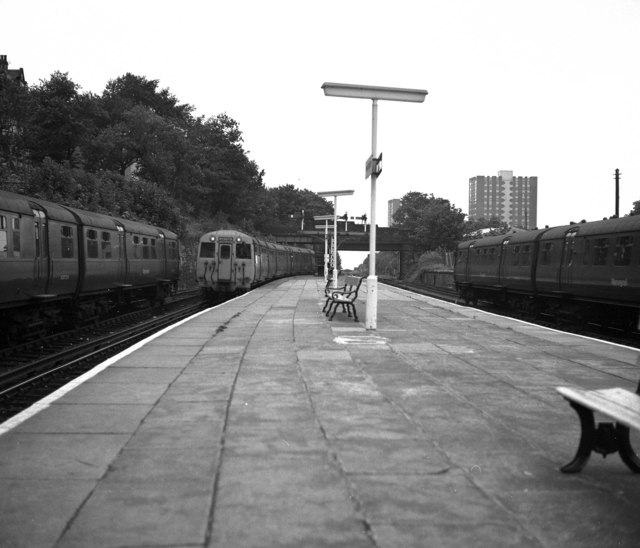
Following on from an internet discussion with people, I argued the case that it was not possible to travel, by train, from Seacombe to New Brighton without changing at Birkenhead North or Bidston. My copy of an ordnance survey map shows this point at the junction from the Seacombe (&Liscard) line and clearly it shows the line to Bhead North where a person would switch tracks and then get the New Brighton train. However, an even earlier copy of a map has come to light (below) showing a 'northern section' from the same Seacombe line turning TOWARD New Brighton. This spur was removed during WW1 and taken to France, and was never replaced due to the increase in regular bus services.
Bidston (West Kirby Line) Originally built by the Hoylake Railway in 1866 as an intermediate station to Birkenhead. After extensions to West Kirby and Birkenhead, through trains to Liverpool began in 1938. Originally known as Bidston Dee Station during the early half of the 20th Century. Diesels run to Wrexham and Chester from Bidston (Now known as the Borderlands Line). Electric trains to West Kirkby and Liverpool. Passengers for Wallasey Village, Grove Road and New Brighton change at Birkenhead North.
Sign by Bidston Church . On the other side it has been painted
out due to the fact that School Lane no longer connects with the http://www.disused-stations.org.uk/features/bidston/index.shtml
Bidston & Sidings 1898
Upton Station (Hooton Line) Upton Station was opened in 1896. The station used to have a booking office, on the road bridge, which spans the two platforms. The booking office was removed during redevelopment of the station & expansion of the road bridge in the 1970s. Each platform also used to have its own waiting room. Adjacent to the station there was a coal & goods yard, which is presently the site of a supermarket. The line is now electrified. It is operated by and staffed Arriva Wales. The line follows the River Fender southwards.
Storeton Station (For Barnston)
Work on the line began on 21st October 1892 and it opened on 18th May 1896. Storeton station opened with the line, but was originally known as Barnston. On 7th August 1896 the D&BC became the NW&LRC and on 1st August 1897 the MS&LR changed its name to the Great Central Railway. Barnston station was in a fairly isolated position just under a mile east of Barnston village, and a mile west of Storeton village. The station was positioned in a shallow cutting on the north side of Station Road. The line was double-track so the station was provided with two platforms. The booking facilities were in a brick over-track building at street level. Steps led down to the platforms on each side of the building. Both platforms had single-storey brick buildings at about the mid-point, and opposite each other. The buildings provided waiting facilities and toilets. The goods yard was sited on the down side of the line south of Station Road and comprised two sidings running parrallel with the line. One of the sidings was very short and served a cattle dock with a cattle pen at its southern end. A signal box, also on the down side, alongside the siding controlled access. On 1st May 1900 Barnston station was renamed Storeton for Barnston. On 1st January 1905 the GCR formally absorbed the insolvent WM&CQR, and the NW&LRC was no more. Storeton and the lines between Wrexham Central, Chester Northgate and Bidston became purely GCR. On 1st January 1923 Storeton for Barnston became a London & North Eastern Railway (LNER) station. In 1933 they officially dropped the �for Barnston� suffix, yet bothBradshaw and the LNER timetable continued to call the station Storeton for Barnston, as did British Railways until its closure. By September 1937 the LNER was running ten trains to Wrexham Central between Monday and Friday and fourteen on Saturdays. Storeton suffered from the effects of road competition. British Railways closed the station to passengers on 3rd December 1951; it remained open for goods until 3rd February 1964. After complete closure it was demolished, and nothing remained of it in 2011. The goods yard has now been put to industrial use. The line itself remained open to passenger and goods services after the station�s closure, but by March 2011 the section through Storeton had no scheduled goods services. An hourly passenger service in each direction was operated by Arriva Trains Wales as part of the Borderlands service connecting Wrexham and Bidston.
Leasowe Station (West Kirby Line)
Moreton (West Kirby Line)
Meols (West Kirby Line) Meols was one of the original stations on the Hoylake Railway, opening in 1866.
Hoylake (West Kirby Line) In the Victorian days, Hoylake was a tiny village with sand dunes. Indeed, men were always at work clearing wind blown sand from the tracks! Between Meols and Hoylake was proposed a new station, Manor. I do not know at this time if it ever came about, but it certainly does not exist now
West Kirby
West Kirby to Hooton
Kirby Park Kirby Park was opened by the GWR and LNWR to cater for growing residential development on the 1st October 1894. The station was situated on the Hooton to West Kirby branch which had opened north of Parkgate in 1886.Kirby Park Station was situated on the north side of Sandy Lane which crossed the line by a road overbridge. The station was provided with one wooden platform, the line being a single track branch, on the east side of the line. A ramp connected the platform to Sandy Lane. The station had a very simple single storey waiting room which was also a wooden construction. A goods siding was provided on the west side of the line.
Thurstaston
Heswall
Parkgate
Hooton
The 'Other End' - Liverpool
From The Illustrated London News - Saturday, September 15, 1860 Street Railways Birkenhead witnessed on the 30th ult. the inauguration of an undertaking which in this country wears all the aspect of novelty. In New York, Boston, Philadelphia and the chief towns of the United States, street railways - the chemin de fer Americain of the French, but better known in England under the designation of horse tramways-have for some years been established. To the success of the experiment in those places in which it has been tried, the testimony of not only the most eminent American engineers, but of intelligent travellers from all parts of the world, has been unhesitatingly borne. Encouraged by that success, attempts have from time to time been made, in vain, to introduce the system into our own metropolis, in the hope of thus remedying the serious inconvenience in its main thoroughfares which is daily caused by an overgrown traffic. It remained for a citizen of the United States to infuse new hope into the supporters of the scheme. To Mr G.F.Train, of Boston, the introduction into England of street railways is mainly to be attributed But five short months have elapsed since he laid the proposals on the subject before the Commissioners of Birkenhead. Two months later found those proposals accepted. The 30th ult. saw them carried int practical effect. Nor was the undertaking inaugurated with a success at all inferior to the expidition with which the necessary works had been completed.The line of rails - which has been laid down under the superintendance of Mr Palles, of Philadelphia, and Mr Samuel, of London, extends from the Woodside Ferry, the landing-place at Birkenhead, just opposite the centre of Liverpool, by the Shore-road, through Angle and Conway streets, and so to the entrance to Birkenhead Park. The whole distance is little more than a mile and a quarter; it is, however, quite sufficient to enable those who take an interest in the subject to form a good idea of the merits of Mr. Train's experiment. A junction in Conway-street enables the carriages to reurn from the park by Hamilton-street to the point from which they originally started. Nothing can well be less complicated than the machinery which is employed for the accomplishment of this double journey. The tramway itself consists simply of two iron plates, each being raised about an inch on the outer side, and running parallel to one another, as in the case of the rails on an ordinary railroad. They are fixed upon longitudinal bearers, which rest upon transverse sleepers, and are so let into the street as to run completely on a level with its surface. They do not, therefore, interfere in the slightest degree with the ordinary traffic. To ply on these iron plates, carriages capable each of affording abundant accommodation to from fifty to sixty passengers have been built by Mr. Main, of Birkenhead. They are more than double the size of an ordinary omnibus, are somewhat similar in shape, and are provided underneath with wheels like those of a railway carriage, but somewhat smaller in size. The plan on which they are constructed would appear to be exceedingly well adapted to street traffic. Each carriage is twenty-four feet long by seven feet wide, seven feet being also the height of the interior from floor to roof. It furnishes sitting room for twenty-four persons inside and for as many more outside, for whose protection a handrail runs round the top. A space of two or three feet intervenes between the passengers on each side of the interior, and this it is proposed to turn to account by allowing passengers to stand there in the event of all the seats being occupied; handrails, with guiding-straps attached, being run beneath the roof for their convenience. A small platform at each end of each carriage, raised about a foot and a half from the ground, and separated from the horses-which may be yoked to either end - by a contrivance somewhat resembling the splashboard of a hansom cab, affords the means of ready ingress and egress to the new conveyances, on the decoration of which, as well as on their adaption to the comfort and security of passengers, great pains have evidently been bestowed. In the construction of the new carriages the important question of ventilation has not been neglected. Each has its sliding windows, with "louvres" to prevent a draught. Each is provided also with a driver and conductor, both of whom have it in their power to control, by means of a patent break, the machinery by which the progress of the carriages is stopped or retarded. Such is the system of street conveyance which on the 30th ult. began its career at Birkenhead. As a mere spectacle its inauguration possessed no particular attraction. Shortly before ten o'clock two of the new carriages were drawn out from the dépôt in Canning-street and placed upon the line. At eleven two horses were yoked to each, and they proceeded on their way well freighted with passengers, gliding along the rails at the rate of about four miles an hour-a rate of speed which might without difficulty be increased to six or seven miles an hour - smoothly and uninterruptedly, turning one or two extreemly sharp curves with the utmost facility, and landing their passengers at their several destinations in security. They continued throughout the day to ply for hire with a success which must have gladdened the hearts of the proprietors, and their progress was, at different points along the route, watched by some hundreds of spectators. To those who witnessed the actual working of the scheme none of its features appeared so prominent as the improvement, so far as increased accomodation is concerned, which it has introduced. Travelling by one of Mr. Train's carriages, as contrasted with one of our ordinary omnibuses, is like quitting a narrow and confined room for a commodius and well-ventilated apartment. On the score of cheapness, it may be added, the new system possesses a decided advantage over that which at present prevails in this country; while, so far as the question of security to passengers is involved, it will be sufficient to state that of 34,000,000 of persons who travelled by the street railways of New York and Brooklyn in 1858 only twelve met with accidents. At a grand déjeûner which Mr. Train gave in the course of the day he received the congratulations of his friends on the success which he had just achieved - a success to which the indefatigable exertions of Mr. Peniston, the secretary to the undertaking, to no small extent contributed. (sorry, forgot who sent me this). |
